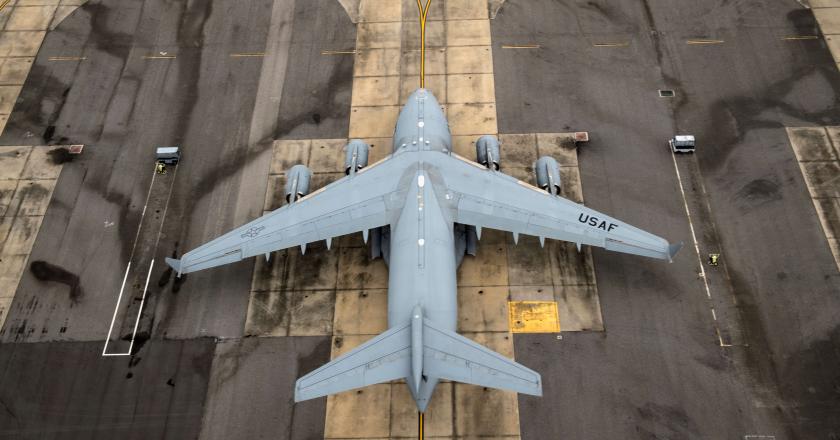U.S. Air Force
John Venable
The mission of the U.S. Air Force has expanded significantly since 1947 when the USAF became a separate service. Initially, operations were divided among four major components—Strategic Air Command, Tactical Air Command, Air Defense Command, and Military Air Transport Service—that collectively reflected the Air Force’s “fly, fight, and win” nature. Space’s rise to prominence in the early 1950s brought with it a host of capabilities that would expand the service’s portfolio and increase its capabilities in the mission areas of intelligence, surveillance, and reconnaissance (ISR) and command and control (C2).
With the birth of the Space Force in December 2019,1 the Air Force began to move its space and space-related personnel assets to the new service. The impact of that change, coupled with the lingering effects of the global COVID-19 pandemic that were highlighted in the 2022 Index of Military Strength,2 continue to hamper the trajectory of the Air Force.
The creation of the Space Force affected three Air Force mission areas: air and space superiority, ISR, and C2. Each of these mission areas was born from air-breathing assets, and while the loss of the space portfolio has reduced the service’s inherent capabilities, they remain within the Department of the Air Force (DAF) and should allow the Air Force to focus the weight of its efforts on core missions in the air and cyber domains.
Today’s Air Force has five principal missions:
- Air superiority (space superiority is now the responsibility of the Space Force);
- Intelligence, surveillance, and reconnaissance;
- Mobility and lift;
- Global strike; and
- Command and control.
Unlike some of the other services, the Air Force did not grow larger during the post-9/11 buildup. Instead, it grew smaller as acquisitions of new aircraft failed to offset programmed retirements of older aircraft. Following the sequestration debacle in 2012, the Air Force began to trade size for quality.3 It was forced to make strategic trades in capacity, capability, and readiness to meet the operational demands of the war on terrorism and develop the force it needed for the future. The collective effects left the Air Force of 2016 with just 55 total force fighter squadrons (the aggregate of Active and Reserve Component squadrons), and the readiness levels within those organizations were very low. Only four of the Air Force’s 32 active-duty fighter squadrons were ready for conflict with a near-peer competitor, and only 14 others were considered ready even for low-threat combat operations.4
Recognizing the threat from a rising China and resurgent Russia, the 2018 National Defense Strategy (NDS) directed the services to prepare for a large-scale, high-intensity conventional conflict with a peer adversary.5 Later that same year, the Air Force released “The Air Force We Need” (TAFWN), a study of the capacity it would need to fight and help the U.S. win such a war. Based on thousands of war-game simulations, TAFWN found that to execute that strategy, the service needed to grow by 25 percent, from 312 to 386 squadrons. This growth included one additional airlift squadron and seven additional fighter, five additional bomber, and 14 additional tanker squadrons,6 which equates to an additional 182 fighter, 50 bomber, 210 air refueling, and 15 airlift platforms.7
During the same period, the service’s most senior leaders emphasized the need for more time in the air for aircrews. Secretary of the Air Force Heather Wilson, for example, “noted that even when air crews go abroad and fly combat missions, such as those against violent extremists such as the Islamic State, they’re not practicing skills that would be required for a high-end fight against an advanced adversary such as Russia.”8 Those demands required a bigger budget, and from 2017 through 2021, the Trump Administration increased DAF funding by 31 percent.9
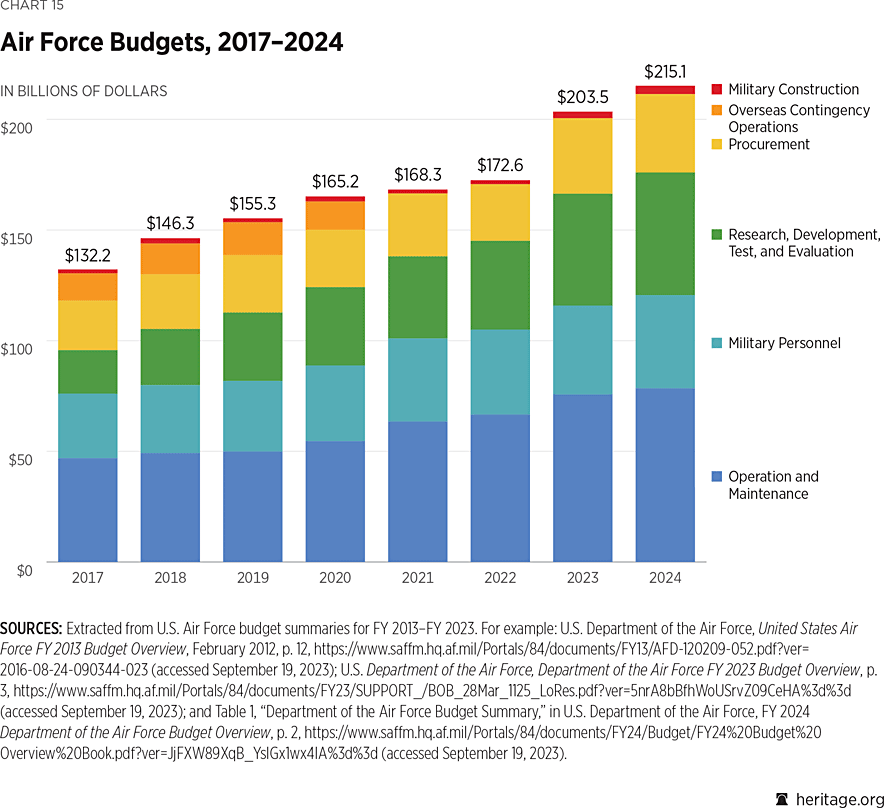
With the shortfall in aircraft and flying hours, the DAF could have used the surge in funding to support significant increases in Air Force capacity, capability, and readiness, but the service chose instead to use much of the additional funding for research, development, test, and evaluation (RDT&E). In 2023 dollars, the DAF budget for RDT&E went from $19.6 billion in fiscal year (FY) 2017 to $55.4 billion in the Administration’s FY 2024 budget, an increase of 226 percent. During that same period, the department’s budget for aircraft procurement increased from $18.9 billion to $20.3 billion, an increase of just 8 percent.10
Funding for flying hours has continued to decline. In FY 2013, the year sequestration decimated the Department of Defense (DOD) budget, the Air Force programmed (budgeted) 1.53 million flying hours across all platforms. Overseas contingency operations added another 0.512 million hours, which meant that Air Force aircraft flew 2.04 million hours.11 In FY 2022, the Air Force budgeted for 1.12 million hours, 27 percent less than the number of hours it flew in 2013, and fell short of executing even that low number by 23,000 hours because of cost fluctuations.12
In April 2022, in spite of TAFWN’s finding that the Air Force was 25 percent too small for its mission sets, it was revealed that the Air Force was planning to cut 1,468 aircraft from its fleet over the Future Years Defense Program (FYDP), including the accelerated retirement of 646 F-15C, F16C, and A-10 fighter aircraft, and that it planned to procure just 246 aircraft over that period.13 In July 2023, the Air Force announced that it would add 103 F-15Es to the roster of retirements.14 This means that a total of 500 of its current fleet of 2,092 fighters will be lost, reducing the fleet by almost 25 percent over the course of the next five years.
Capacity
At the height of the Cold War buildup in 1987, the active-duty Air Force had an inventory of 3,082 fighter, 331 bomber, 576 air refueling, and 331 strategic airlift platforms. When the strategic reserve assets within the Air National Guard and Air Force Reserve are added, the 1987 totals were 4,468 fighter, 331 bomber, 704 air refueling, and 362 strategic airlift platforms. After the fall of the Iron Curtain, the United States shifted from a force-sizing construct centered on great-power competition to one capable of winning two simultaneous or nearly simultaneous major regional conflicts (MRCs). Those numbers for capacity have been reduced significantly over the years.
It is projected that at the end of FY 2023, the Air Force will have a total aircraft inventory (TAI) of 2,092 fighters, 141 bombers, 471 tankers, and 274 strategic airlift platforms. With the rollout of the President’s budget for FY 2024, the service announced its plan to eliminate 60 fighters and nine bombers from its inventory, which will bring its total force TAI to 1,932 fighters, 140 bombers, 471 tankers, and 274 strategic airlift platforms.15 At that point, the Air Force will have a total force that equates to 47 percent of the fighter, 43 percent of the bomber, 67 percent of the tanker, and 76 percent of the airlift assets it possessed the last time the United States was prepared to fight a peer competitor.
The idea that aircraft production lines will somehow surge to come to the rescue in a peer-level crisis might seem plausible to some,16 but even if Congress were to throw an unlimited amount of funding at production lines, it would take from two to three years for those additional assets to arrive.17
The Index of U.S. Military Strength uses “combat-coded” fighter aircraft within the Active Component of the U.S. Air Force to assess capacity. Combat-coded aircraft and related squadrons are aircraft and units with an assigned wartime mission, which means that those numbers exclude units and aircraft that are assigned to training, operational test and evaluation (OT&E), and other missions.
The software and munitions carriage and delivery capability of aircraft in units that are not combat-coded renders them incompatible with and/or less survivable than combat-coded versions of the same aircraft. For example, all F-35As may appear to be ready for combat, but training wings and test and evaluation jets have hardware and software limitations that would severely curtail their utility and effectiveness in combat. Even if those jets were slated for upgrades, hardware updates sideline jets for several months, and training wings and certain test organizations are generally the last to receive those upgrades.
Of the 5,154 manned and unmanned aircraft projected to be in the USAF’s inventory at the end of FY 2023, 1,432 are active-duty fighters, and 886 of those are combat-coded aircraft.18 It is important to separate the active-duty fighters and units from the strategic reserve because it would take several months to get elements of the latter up to manning and readiness levels that allowed their first elements to deploy. Unfortunately, other factors also affect the number of fighters the service could actually employ in combat.
Most squadrons will have to pack up and deploy several thousand miles to be able to fight. Because of the additional wartime manning requirements and the fact that most squadrons have several jets that need repairs at any given time, it takes the resources of approximately three active-duty squadrons to deploy two combat-capable fighter units forward.19 That effectively reduces the total number of active-duty, combat-coded fighters to 571 jets.
The Air Reserve Component has 608 fighters, approximately 458 of which are combat coded. Because of the additional wartime manning requirements and the fact that Guard and Reserve units generally have just one squadron at each location, it takes two squadrons to deploy one combat-capable unit forward.20 In terms of capacity, this means that 626 active-duty and 229 strategic reserve fighters, for a total of 885 combat-coded fighters, could be deployed into combat, leaving virtually nothing in reserve. However, recent squadron deployments in response to a request from the Commander of U.S. European Command following Russia’s invasion of Ukraine were fulfilled with 12 jets—packages that were referred to as “squadrons,” implying that the Air Force has reduced the number of fighter aircraft normally associated with the term “squadron” from 24 to 12.
Capacity also relies on the stockpile of available munitions and the production capacity of the munitions industry. The actual number of munitions within the U.S. stockpile is classified, but there are indicators that make it possible to assess the overall health of this vital area. The inventory for precision-guided munitions (PGM) was severely stressed by nearly 18 years of sustained combat operations in Iraq, Afghanistan, Syria, and elsewhere and by budget actions that limited the service’s ability to procure replacements and increase stockpiles. From 2017 through 2021, funding for munitions was significant, and the service, believing the inventory is now sufficiently restocked, has reduced the number of PGMs it will acquire to a total of 9,486 munitions in FY 2024.21
However, even though the munitions stockpile may have returned to a level that is high enough to support a surge in expenditures associated with a conflict similar to the global war on terrorism—loosely encompassing operations in Afghanistan and Iraq—it probably would not support a peer-level fight that lasted more than a few weeks. Typically, there is a delay of 24–36 months between funding and delivery of additional munitions, and while the potential exists for a rapid expansion of production, it is hard to envision how such an expansion could be rapid enough to exceed demand before the stockpile is depleted. (See Table 11.)
Advances in the jamming of global navigation satellite systems (GNSS) like GPS have been significant over the past 20 years, and the number, types, and effectiveness of jammers are growing.22 In the days leading up to its invasion of Ukraine in February 2022 and throughout its combat operations since then, Russia has used its systems to jam signals in the region to hamper the employment of Ukrainian and Allied GNSS guided weapons systems against its troops and equipment, and the areas covered by the effects of those systems can be considerable.23 The employment of such systems in a war with a peer adversary could significantly diminish the accuracy of weapons like Joint Direct Attack Munitions (JDAMs) and Small Diameter Bombs (SDBs) that rely on reliable Global Positioning System (GPS) guidance to hit their targets.
Although there has been significant research focused on making munitions less susceptible to the effects of GPS jammers, there is little evidence that such munitions would retain their accuracy during a full-up conflict with a peer adversary. Attacking targets in that environment using GPS guidance alone might require many more munitions and sorties than would otherwise be necessary, depleting the inventory of GPS guided munitions much faster and with markedly less effect than is likely contemplated by current war plans.
The only weapons in the U.S. inventory that can fully counter GPS/electronic jammers and reliably hit their targets are those that can track physical targets with laser, optical, or infrared seeker heads. The Air Force has not acquired PaveWay or Maverick missiles for several years, and most GPS guided munitions do not have seeker heads or a secondary capability to track and guide on a target in a degraded GPS environment.
To cover this gap, the Air Force has added a laser guidance capability to its already effective GBU-53 Small Diameter Bomb (SDB I). Known as the SDB II, the improved weapon “uses Link 16 and ultra-high frequency datalinks, along with infrared guidance, to provide course corrections” and hit “both fixed and moving targets.”24 Unfortunately, the service has not yet acquired the SDB II in numbers that would be required for conflict with a peer competitor.
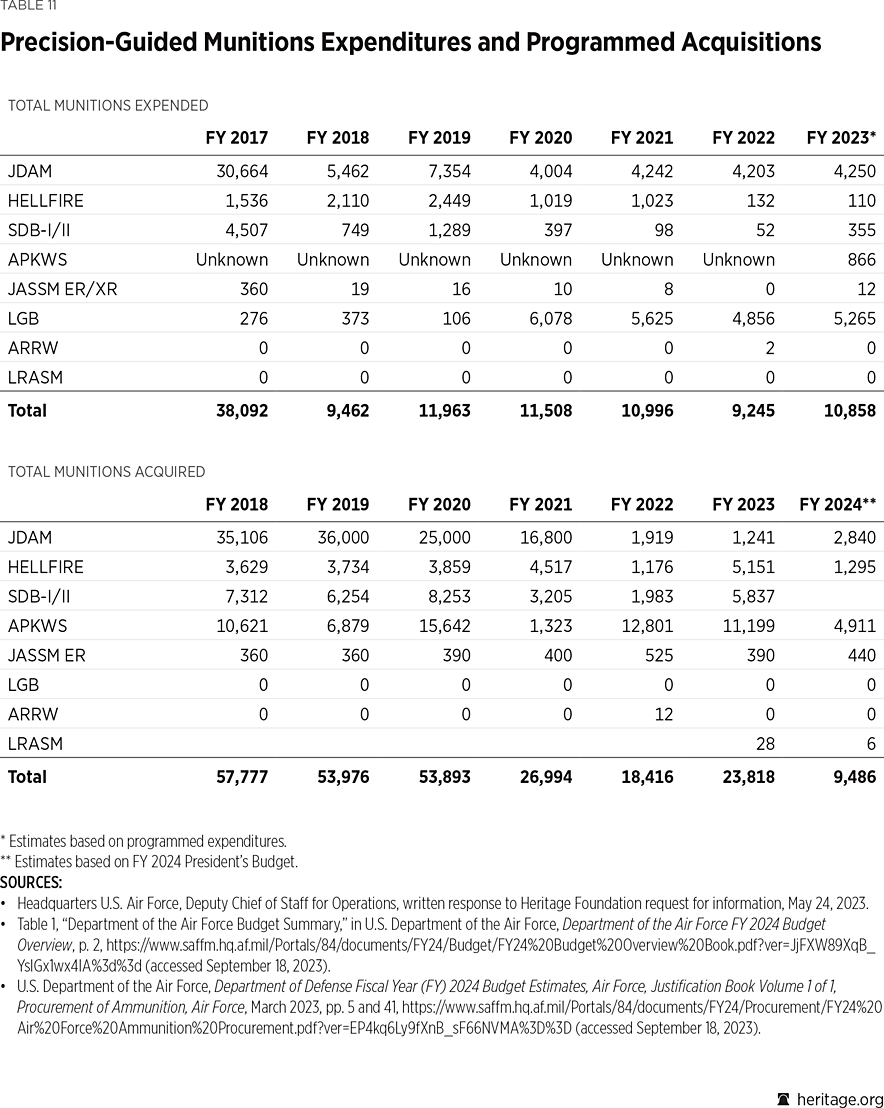
Capability
The risk assumed in capacity has placed an ever-growing burden on the capability of Air Force assets. The ensuing capability-over-capacity strategy centers on the idea of developing and maintaining a more capable force that can win against the advanced fighters and surface-to-air missile systems now being developed by top-tier potential adversaries like China and Russia, which are also increasing their capacity in this area.
Any assessment of capability includes both the incorporation of advanced technologies and the overall health of the inventory. Most aircraft have programmed life spans of 20 to 30 years based on a programmed level of annual flying hours. The bending and flexing of airframes over time in the air generates predictable levels of stress and fatigue on everything from metal airframe structures to electrical wiring harnesses.
The average age of Air Force aircraft is more than 30 years, and in some fleets, such as the B-52 bomber, it is more than 62 years. In addition, KC-235s comprise 76 percent of the Air Force’s 471 tankers and are more than 61 years old on average. By the end of FY 2024, 102 brand-new KC-46s will make up 21 percent of the tanker inventory, but they will not currently be capable of refueling aircraft during combat operations—the jet’s primary mission.25
The Air Force estimates that the fix for problems in the KC-46’s refueling boom and remote vision system (RVS) should be ready by the spring of 2024. Assuming the boom and RVS redesign goes as planned, retrofitting jets that the service has already accepted will take several years, and the operational impact of that process will be significant: 103 strategic air refueling assets will be unusable in real-world operations in 2024. That number will grow to 110 jets in 2025, equating to 23 percent of the fleet that will be unable to fulfill operational taskings reliably.26
The average age of the F-15C fleet is 39 years,27 significantly exceeding the programmed service life of a fleet that still comprises more than half of USAF air superiority platforms.28 The F-16C fleet is more than 33 years old,29 and to extend their lives even further, 300 of those jets are undergoing a major service life extension program (SLEP) that will allow them to fly through 2050.30 These modifications are costly, and the added expense reduces the amount of funding the service has to invest in modernization, which is critical to ensuring future capability. Even with a SLEP, there is a direct correlation between aircraft age and the maintainability of those platforms. (See Table 12.)
The Air Force’s ISR and lift capabilities face similar problems in specific areas that affect both capability and capacity. The majority of the Air Force’s ISR aircraft are now unmanned aerial vehicles (UAVs). The Air Force will divest 38 MQ-9 Block-1 aircraft in FY 2024, leaving a total of 208 Reapers.31 The service divested the last of its fleet of EQ-4s and Block 30 RQ-4s in FY 2021 and FY 2022, respectively. The RQ-4 Block 40 fleet remains in service, and the RQ-4 Block 30 mission will be carried on by the 40-year-old U-2, which is scheduled to be divested by the end of the current FYDP.32
The E-8 Joint Surveillance Target Attack Radar System (J-STARS) and RC-135 Rivet Joint are ISR platforms built on the Boeing 707 airframe, and the last one came off the production line 44 years ago. The Air Force will divest its last three remaining E-8s in FY 2024.33
The Air Force is working on an incremental approach for a J-STARS replacement that focuses on advanced and disaggregated sensors (a system of systems) that would require enhanced and hardened communications links. Known as the Advanced Battle Management System (ABMS), it is envisioned as an all-encompassing approach to both airborne and ground Battle Management Command and Control (BMC2) that would allow the Air Force both to fight and to support joint and coalition partners in high-end engagements.34
With respect to air combat, the Air Force will retire 57 more F-15C/Ds in FY 2024, leaving just 92 in its inventory.35 Concerns about what platform will fill this role when the F-15C is retired are fully justified. Just 186 of 750 planned F-22A stealth air superiority fighters were acquired to replace the F-15C,36 and the service has announced its intent to retire 33 Block 20 F-22s in FY 2024. If those jets are retired,37 the fleet will be reduced to just 153 jets.38
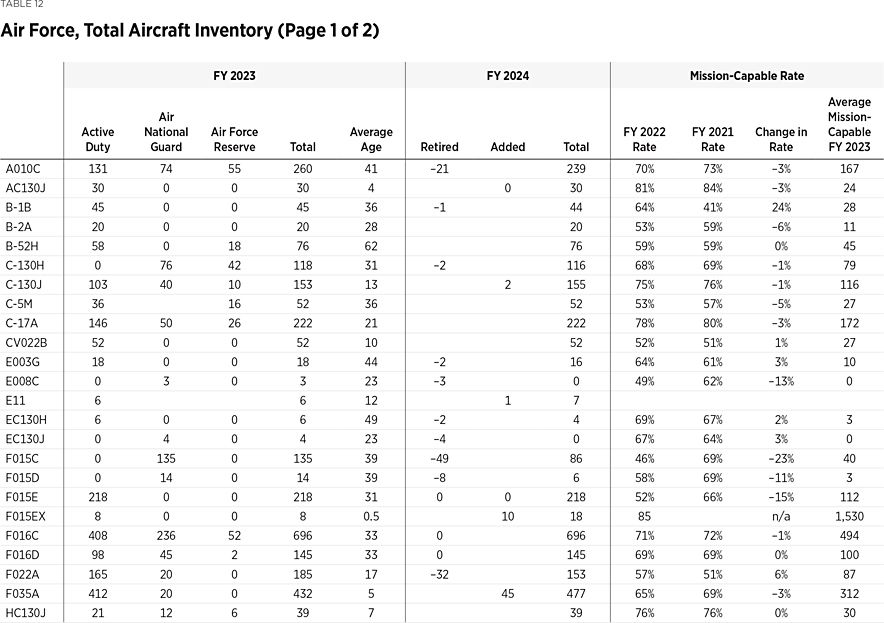
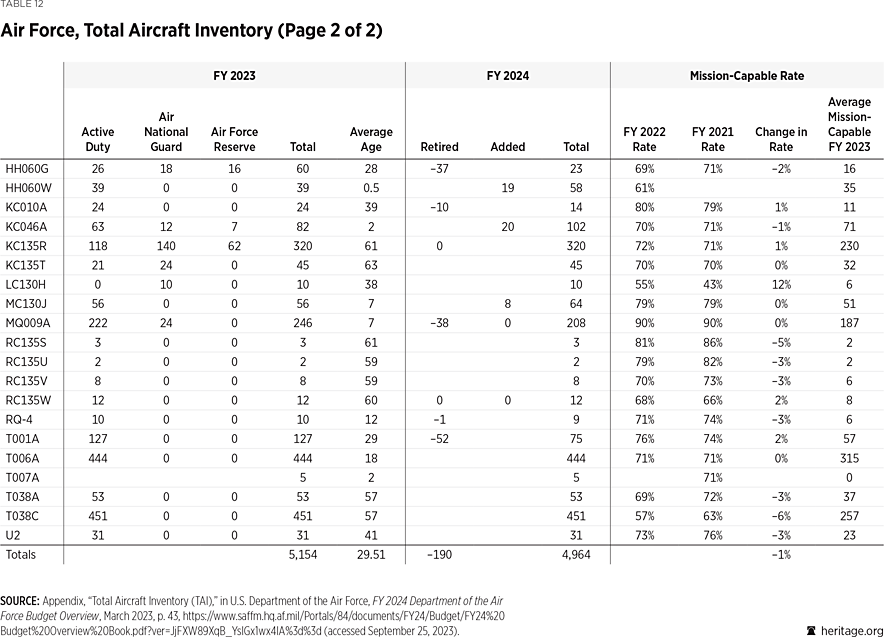
The service’s already low ability to fulfill operational requirements for air superiority fighters will be further strained by a 10-year program, intended to refurbish the low-observable coatings on the F-22’s engine inlets and inspect and overhaul the aircraft’s flight control system, that will run through 2031.39 That program, which will take aircraft that are to be refurbished out of operational availability, coupled with the F-22’s low mission capability rate, would significantly hobble the availability of this system in a fight with a peer competitor.
The Air Force continues to acquire the F-35A, and the President’s budget for FY 2024 would support acquisition of 48 of these multirole stealth fighters. The jet achieved full operating capability (FOC) in 2018 and flew for the first time with the long-awaited Block 4/Technical Refresh-3 (TR-3) on January 6, 2023.40 The F-35A’s multirole design favors the air-to-ground mission, but its fifth-generation faculties will also be dominant in an air-to-air role, allowing it to augment the F-22A in many scenarios.41
The F-35A is programmed to receive $5.8 billion in funding over the FYDP. At that level, it is eighth on the DAF funding priorities list, preceded by Next Generation Air Dominance (NGAD) at $22.06 billion; the Ground Based Strategic Deterrent (GBSD) at $14.9 billion; the B-21 at $10.6 billion; Resilient Missile Warning Missile Tracking-Low Earth Orbit at $9.7 billion; Space Technology Development and Prototyping at $9.3 billion; the Survivable Airborne Operations Center at $8.1 billion; and Evolved Strategic Satellite Communications (SATCOM) at $6.8 billion. In other words, the only fifth-generation U.S. fighter in production has a significantly lower priority than strategic bomber, satellite, and F-22 air dominance replacement programs even though the Air Force is substantially short of the combat-coded aircraft that would be needed to win a war against any peer or near-peer opponent.
NGAD is not expected to begin fielding until 2030 at the earliest, and while the B-21 has yet to fly, the program has completed an Integrated Baseline Review for the overall B-21 development effort as well as the jet’s Preliminary Design Review. The Air Force is committed to a minimum of 100 B-21s at an average cost of $639 million per plane in FY 2019 dollars.42
With the budget agreement that was reached for FY 2018 and FY 2019, the Secretary of the Air Force announced the USAF’s intent to retire all B-1s and B-2s and sustain a fleet comprised of 100 B-21s and 71 B-52s.43 The B-21 Raider and B-52s “will form a two-bomber fleet that will incrementally replace the aging fleet of B-1 Lancer and the B-2 Spirit bombers,” and the B-21 is “slated to hit full operations in the mid-2020s.”44 The Air Force retired 17 B-1s in 2021 and continues to execute a SLEP on the remaining fleet of 44 to restore the bomber’s engines to their original specifications. The Air Force had planned to modernize the B-2’s Defense Management System but cancelled the plan in 2021 because of a software coding mismatch with its legacy computer system.45 Stores Management Operational Flight Program and Common Very-Low-Frequency/Low Frequency Receiver Program elements will be fielded to ensure that this penetrating bomber remains viable in highly contested environments, keeping it fully mission-capable until it is replaced by the B-21.46
Modernization efforts for the B-52 are also underway. The jet was designed in the 1950s, and the current fleet entered service in the 1960s. The FY 2018 budget funded the re-engineering of this fleet with upgrades that include a new Long-Range Standoff (LRSO) cruise missile, improved radar, new computers, new communication links, and a new suite of electronic warfare countermeasures. The aircraft will remain in the inventory through 2050,47 which means that a significant portion of the U.S. bomber fleet will be more than 80 years old.
Acquisition of the KC-46A air refueling tanker is another critical enabler for the service. As previously noted, the KC-46 has experienced a series of problems and delays, the most recent of which involves the air refueling system that currently cannot refuel fighters in an operational environment. The Air Force will have 95 KC-46s by the end of FY 202348 and will acquire another 84 tankers for a total of 179 by the end of FY 2029. The KC-46 will replace less than half of the current tanker fleet and will leave the Air Force with more than 200 aging KC-135s (already averaging 61 years old) that still need to be recapitalized.49
When the Secretary of the Air Force and the Chief of Staff of the Air Force rolled out “The Air Force We Need” in 2018 to expand the number of squadrons from 312 to 386, one of their goals was to fill the ranks of those new squadrons with only the newest generation of aircraft—F-35s, B-21s, and KC-46s—because of the capabilities that those platforms bring to bear.50 Curiously, the Air Force is now acquiring the fourth-generation F-15EX, based primarily on the ill-conceived notion that it will be cheaper to acquire and operate than the F-35A, instead of buying the country’s only fifth-generation aircraft in production.51 The FY 2024 budget funds 24 more F-15EXs and signals an intent to cap the purchase at just 80 jets. With the latest cuts in the fighter force, the service has reversed course on its stated intent to use them to replace Air National Guard F-15Cs; instead, approximately half of the F-15EX fleet will be fielded in active-duty units. Although the service will offset some of its fighter fleet retirements with this new hardware, the F-15EX is a step backwards and will not be survivable in anything more than low-threat environments by the time this weapons system reaches initial operating capability (IOC).
Readiness
The 2018 National Defense Strategy’s focus on peer-level war was designed to facilitate a clear and rapid paradigm shift away from the tiered levels of readiness the Air Force had adopted because of years of relentless deployments and funding shortfalls. In a move that would refine the service’s focus on great-power competition as spelled out by the new NDS, Secretary of Defense James Mattis directed the Air Force to increase the mission-capable (MC) rates of the F-16, F-22, and F-35 aircraft to 80 percent by the end of September 2019.52 The move was designed to make more of an all-too-small fleet of combat aircraft available to deploy in the numbers required to deter or defeat a peer adversary.
Early in 2019, then-Air Force Chief of Staff General David Goldfein stated that the service would likely not meet the 80 percent MC threshold directive until 2020, and in the spring of 2020, he made it clear that the threshold was no longer a focus for the Air Force. MC rates are a measure of how much of a certain fleet is “ready to go” at a given time, and the general stated in clear terms that he regarded the statistic as an inaccurate portrayal of the service’s overall health.
Instead of using that historic marker for readiness, the service moved to highlight how deployable a portion of any fleet was within a short period of time53 and shifted its focus to the number of “force elements”—fighters, bombers, and tankers—that it has across the Air Force and how quickly those forces need to be ready. One of the examples that Goldfein used was the rapid deployment of a “task force” of four B-52s to the Middle East in May 2019.54 The bombers, from Barksdale Air Force Base, Louisiana, had two days from notification to deployment, and while the ability to deploy four of 58 operational bombers rapidly is a capability, it is one that is more in line with responding to a regional contingency than it is with taking on a peer adversary.
In the USAF’s FY 2020 posture statement, Secretary Wilson and General Goldfein said that “more than 90 percent of our pacing squadrons are ready to ‘fight tonight’ with their lead force packages” and that “these pacing squadrons are on track to reach 80% readiness before the end of Fiscal Year 2020.”55 A short time later, however, the service abandoned even the illusion that it was working to achieve that goal, and by 2022, a new service chief, General Charles Brown, had abandoned the pacing squadron concept and released an article on the need to redefine readiness.56
Unfortunately, the FY 2022 Air Force posture statement offered no more clarity or assurances of readiness; instead, it moved to change the paradigm of readiness into a three-phase force-generation model designed to “articulate readiness impacts and capacity limits.”57 In FY 2023, it morphed again into what is now known as the Air Force Generation (AFFORGEN) model, dividing the deployable combat Air Force into four six-month phases of readiness known as “Ready, Available to Commit, Reset, and Prepare.” In theory, the model “builds high-end and sustainable readiness toward future missions by balancing elements of current availability, modernization and risk,”58 but from the outset, it represents little more than an attempt to change the dialogue surrounding what are perhaps the lowest levels of readiness in Air Force history.
In 2017, Secretary Wilson and General Goldfein informed Congress that “[w]e are at our lowest state of full spectrum readiness in our history.”59 In the six years since their testimony, DOD has stifled open conversation or testimony about readiness, limiting the Air Force’s ability to be forthcoming with open-source readiness indicators. Although this makes any assessment of readiness difficult, there are three areas that can support an assessment:
- MC rates,
- Aircrew training, and
- Deployability.
MC Rates. MC rates are defined as the percentage of a unit’s aircraft that are capable of executing its mission set. Multiplying MC rates by the actual number of aircraft within a particular fleet yields the physical operational capacity of a weapons system. Several factors drive MC rates. The two most common to mature systems are operations and maintenance (O&M) funding and qualified manning to generate, fix, and fly those jets. Collectively, they dictate the number of sorties and flight hours that units have available for aircrew training.
The last time the United States was prepared to fight a peer competitor, the Air Force had more than 700 F-15C air superiority fighters with a fleet MC rate of more than 80 percent. If only 500 were combat-coded, more than 400 mission-capable jets were ready to fight the Soviet Union. Conversely, there are 186 F-22As in the total aircraft inventory, but 28 are dedicated trainers and 16 are primary development aircraft inventory used for testing new equipment, which leaves just 142 operational jets. In 2022, the F-22A had an MC rate of 57 percent, which means that just 81 F-22As could be committed to combat at any given time.60 Although the F-22A is an incredibly capable fighter and 81 F-22s would be a formidable capability against a regional threat, that number would be grossly insufficient for a peer fight.
Similarly, there are 33 operational B-1s in the Lancer fleet.61 With an MC rate of 55 percent in FY 2022, 18 are available for combat at any given time during the year. The B-2 fleet’s small size and 53 percent MC rate mean that, on average, just 10 are combat capable. If the B-52’s 58-plane operational fleet and 59 percent mission-capable rate are added, a total of 63 Air Force bombers were capable of executing combat missions on any given day in 2022.62 (For a summary of the mission-capable rates for combat-coded aircraft of the five fighter weapons systems, see Table 14.)
Maintenance manning remains relatively healthy across the board. (See Table 15.) If funding for flying hours and spare parts were robust, MC rates would rise, giving pilots more sorties and the ability to sharpen their combat mission-capable skills. Unfortunately, funding for flying hours increased only marginally in the years immediately following sequestration, and the number of available sorties falls well short of the minimum number required for pilots to be considered combat mission capable.
Aircrew Training. Unlike maintenance manning, the pilot shortage continues to plague the service. In March 2017, Lieutenant General Gina M. Grosso, Air Force Deputy Chief of Staff for Manpower, Personnel, and Services, testified that at the end of FY 2016, the Air Force had a shortfall of 1,555 pilots. Of that total, the service was short 1,211 fighter pilots: 873 Active and 338 from the Active Reserve Component (ARC).63 The Total Force shortfall in 2022 was 1,650: 650 Active and 1,000 ARC,64 and while the Air Force would not provide the 2023 shortfall, it is very unlikely that the shortfall has not decreased.
The Air Force graduated 1,200 pilots in FY 2018 and 1,279 in FY 2019, and despite projections that 1,480 would receive their wings in 2020, COVID-19 reduced the throughput so that just 1,263 graduated from flight school. Another 1,381 graduated in FY 2021. The Air Force would not provide the 2022 graduation rates and estimates for FY 2023.
Those projected numbers rely on a very high annual graduation rate of approximately 94 percent of the candidates that enter flight school during any given year. In 2021, just 0.27 percent of flight school candidates were eliminated based on performance. The vast majority of those who washed out were eliminated for health, discipline, or other reasons that were not specifically related to performance.65 The Air Force would not provide the 2022 washout rates.
Throughout the pilot shortage, the Air Force has done its best to prioritize operational unit manning instead of placing experienced fighter pilots at staffs and schools. Nevertheless, the currency and qualifications of the pilots in operational units are critically important to readiness. Air Force regulations have set minimum thresholds for sorties based on experience levels, and a series of Air Force regulations, known as the Ready Aircrew Program (RAP), dictate that inexperienced fighter pilots in combat-coded units must fly nine sorties a month and that experienced pilots must fly eight to be considered mission capable.66 However, those numbers are minimum thresholds, and the tables that follow show that Air Force pilots are not meeting even those requirements. While the quality of sorties is admittedly subjective, a healthy rate of three sorties a week and flying hours averaging more than 200 hours a year have been established as “sufficient” over more than six decades of fighter pilot training.67 In the words of General Bill Creech, “Higher sortie rates mean increased proficiency for our combat aircrews,”68 and given the right number of sorties and quality flight time, it takes seven years beyond mission qualification in a fighter for an individual to maximize his potential as a fighter pilot.69
Flying hours and sortie rates across all fighter platforms fell to historic lows during the COVID-19 pandemic, and the average line mission-ready fighter pilot received fewer than 1.4 sorties a week and less than 131 hours of flying time per year.70 At those levels, pilot competence and confidence drop to the point where excellent pilots begin to question their ability to execute even very basic tasks. In a speech delivered on September 21, 2022, General Mark Kelly, Commander, Air Combat Command, stated that the average fighter pilot received just 6.8 hours of flying time per month (less than two hours per week) for a total of 81.6 hours in 2021.71 No matter which data point is selected, the numbers reflect an Air Force that would struggle in a fight with a regional competitor and could well founder in a war with a peer adversary.
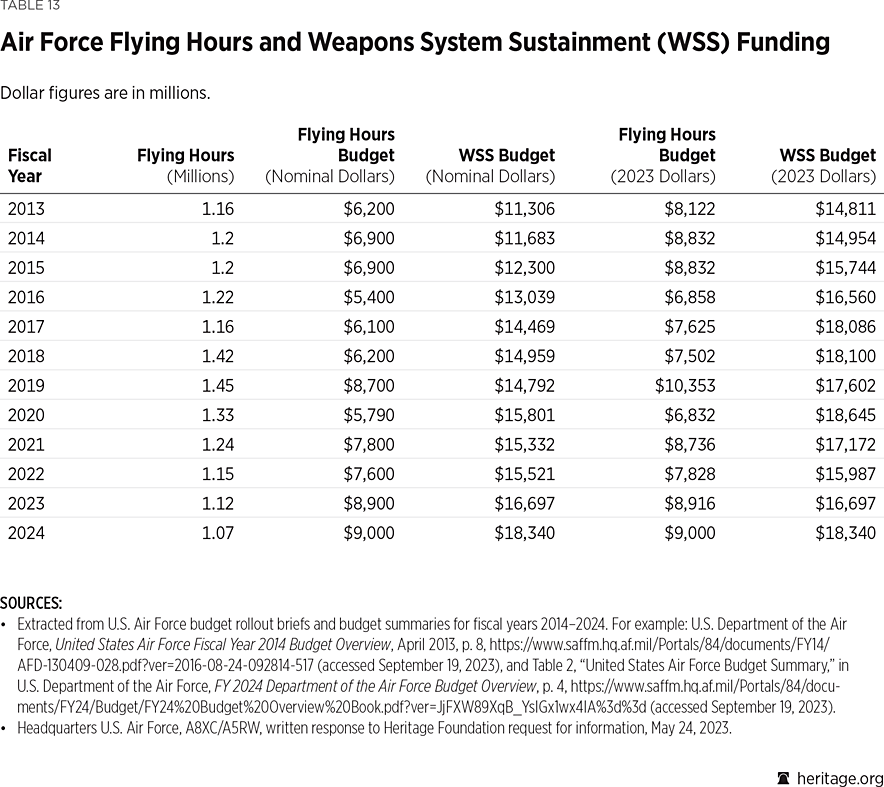
The last time fighter pilots received an average of 150 hours of flying time and more than two sorties a week for an entire year was in 2015 when the service was beginning to recover from sequestration. In spite of a budget that has increased by more than 75 percent in the years since then, the number of flying hours the Air Force funds has remained very low, and the service has failed to execute the programed number of hours year after year. In other words, even when funding has been available, the service has failed to use it to improve pilot readiness. Some argue that the lack of hours in the cockpit is being offset by time/sorties in high-fidelity simulators, but this presumes that simulator time is an effective substitute for time in a real aircraft. The Air Force RAP requires inexperienced F-35 pilots to fly a minimum of nine times a month in the jet and a minimum of three times a month in high-fidelity simulators.72 The average line F-35 pilot received just six sorties and 2.2 simulators a month in 2022, which means that by definition they are not combat mission capable.
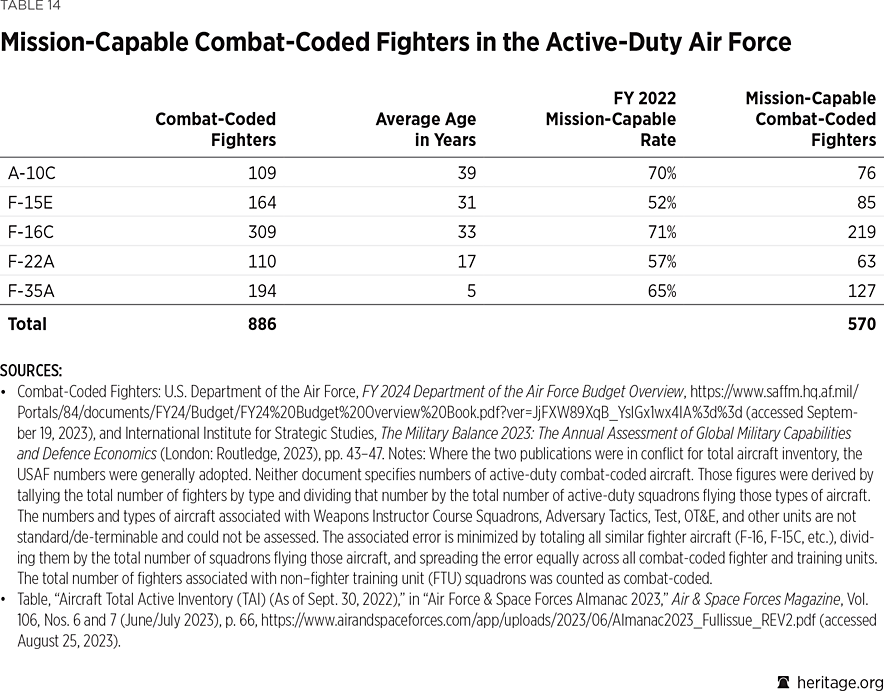
Prioritizing readiness and significantly increasing funding for the flying hour program could easily resolve this issue, but the service has been hobbling itself for years. The flying hours funded within the service’s budget dropped from 1.33 million in FY 2020 to 1.24 million in FY 2021 to 1.15 million in FY 2022,73 and even then, the service was able to fly only 1.097 million hours before the account ran out of money. The number of hours funded fell again to 1.13 million in FY 2023 and has declined still more to 1.07 million in the President’s budget for FY 2024.74 It should be noted that the service budgeted for and actually executed more flying hours in 2013, the year sequestration drove draconian cuts in DOD’s budget, than it has in any of the past three years.75 Every reduction has been accompanied by a note stating that the hours were budgeted to “the maximum executable level,” but that is at best misleading because the only constraint beyond funding is maintenance manning, which has been healthy since 2019. (See Table 15.)
The current generation of fighter pilots—those who have been actively flying for the last seven years—has never experienced a healthy rate of operational flying. It will take several years of flying three or more sorties a week to regain the level of competence required to dominate a peer competitor, but the Air Force is not moving to make that happen. Readiness as measured by the Air Force’s long-standing metrics is incredibly low, and the criteria for the Chief of Staff’s “Redefine Readiness or Lose” concept remain undefined.76 Continuing down this path will further erode combat capability, competency, and flight safety for Air Force pilots.

Deployability. Because long-term inspections and depot-level work affect the availability of support equipment and aircraft, it takes three active-duty squadrons to deploy two squadrons forward. On any given day, units have several aircraft that are not flyable because of long-term inspections, deep maintenance, or the need for spare parts. By using aircraft from one of the three squadrons to “plus up” the other two, the wing could immediately deploy two full-strength units into combat. The handful of fully flyable jets and pilots left at the home station could then be used to train new and inbound pilots up to mission-ready status so that, among other things, they could replace pilots that were lost during combat.77 Up until the end of the Cold War, the Air Force was organized using a three-squadron wing to handle the associated load.
Normally, active-duty fighter squadron manning levels are based on a ratio of 1.25 aircrew members for every aircraft,78 which means that a unit with 24 assigned aircraft should have 30 line pilots and five supervisor pilots who are combat mission ready.79 Flight times, sortie rates, mission planning teams, and flight supervision requirements are significantly higher in combat, and to cover those requirements, the manning ratio normally increases to 1.50 pilots per aircraft, or 36 line pilots per squadron. In other words, every squadron deployed to fight requires six more pilots than it has on its roster.80 Pilots from “donor” squadrons can fill those slots for the deploying units.
With the downsizing that has taken place since the end of the Cold War and the reduction in the number of fighter squadrons, the Active Air Force has reduced the number of fighter squadrons to two or even one in many wings. All operational Guard and Reserve wings are comprised of a single squadron, which complicates the math behind the total number of deployable fighter squadrons.81
Of the 54 operational fighter squadrons on the Air Force roster, 31 are Active and 23 are Guard or Reserve Units. (See Figure 4.) Using the notion that it takes three squadrons to get two active-duty squadrons forward, the airframe disposition of each active-duty wing would allow just 21 active-duty fighter squadron equivalents (with 24 fighter aircraft each) to deploy to a fight. This equates to 480 active-duty fighters that could deploy to meet a crisis situation, which is well short of the 600 it takes to win a single MRC and means that a war with a peer competitor would draw heavily on the service’s strategic reserve.
Guard and Reserve units face the same manning and deployment challenges that the active-duty force faces, except that the vast majority of those units have just one fighter squadron per wing, further straining their ability to muster the airframes and manning needed to meet an emergency deployment.82 Planning for low-threat, low-intensity deployments to Operation Iraqi Freedom and Operation Enduring Freedom took this into consideration by mapping deployments out months (often years) in advance of the required movement, allowing pilots to deconflict their civilian work schedules not just for the deployment, but also to get the training and time in the air that they needed to employ successfully in those low-threat combat operations.83 Nevertheless, it was common for Guard units to pull pilots from other units to fulfill manning requirements for “rainbow” fighter squadrons.84 In a conflict where there is little time from warning order to deployment, it would likely take two Guard and Reserve squadrons to enable one to deploy forward.85
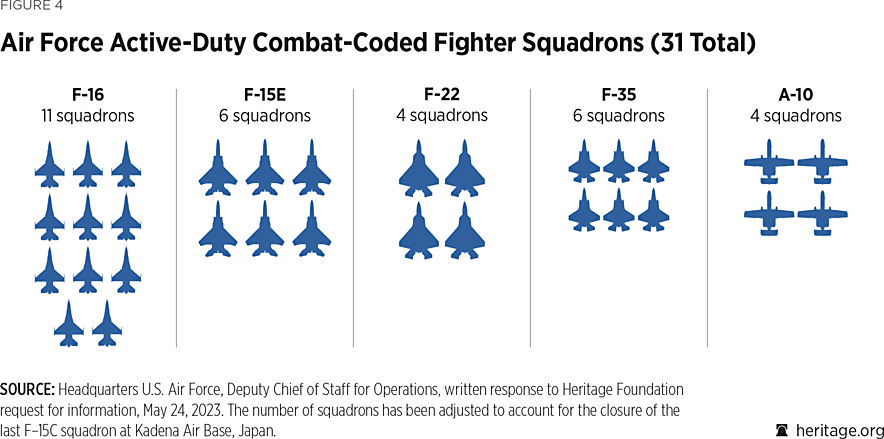
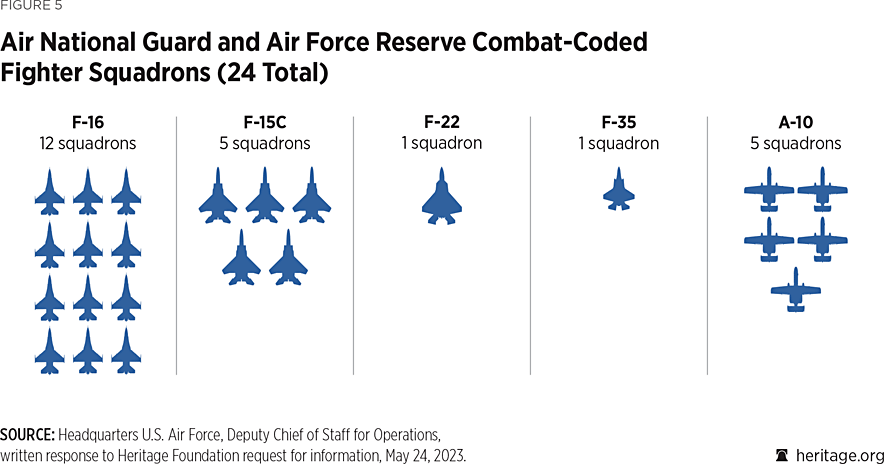
The average Guard and Reserve fighter squadron has one-third fewer jets than similar active-duty units have. By rainbowing units with similar aircraft, the Guard and Reserve could muster 12 squadrons as a strategic reserve of 288 fighters that could deploy sometime after the active-duty units deploy. In other words, the service could muster just 768 fighters (480 Active and 288 Guard and Reserve) for a peer-level fight. The Guard and Reserve numbers do not just limit deployable airframes. Other factors such as manning levels would also limit the number of sorties and the amount of combat power that those fighters could generate continually in a high-end confrontation with a peer competitor.
The declaration in Air Force posture statements for FY 2020 and FY 2021 that lead force packages within the service’s 204 pacing squadrons are ready to fight conveys the fact that only portions of its most capable squadrons have enough mission-capable aircraft and aircrews that are “closer” to the minimum Combat Mission Capable sortie requirements to respond somewhat readily to a crisis. Because of the pilot shortage, actual unit manning levels in fighter squadrons are below peacetime requirements, which is already not enough to meet the increased demands and the tempo required for combat operations. While the Active Component would not release its figures on fighter unit manning, the Air National Guard (ANG) released their manning levels, which should be representative for active-duty units as well. Currently, ANG fighter units are manned at 88 percent, which brings the pilot-to-aircraft ratio down to 1.1:1—significantly lower than the planned 1.25:1.
The service has already moved the majority of pilots who were assigned to staff or other non-flying billets back to the cockpit to deal with the most critical aspect of the manning shortfall. Thus, the only way units can meet wartime manning requirements is by pulling pilots from other “donor” squadrons. The complications involved are significant and suggest that the portions of the 54 fighter squadrons that are unable to deploy immediately in a crisis could be combined to create more combat power. Unfortunately, the majority of aircraft and aircrew that are left are needed for homeland defense, to train replacement pilots, or to replace aircraft that are lost through combat attrition.
Scoring the U.S. Air Force
Capacity Score: Marginal
In responding to major combat engagements since World War II, the Air Force has deployed an average of 28 fighter squadrons. Based on an average of 18 aircraft per squadron, that equates to a requirement of 500 Active Component fighter aircraft to execute one MRC, and adding a planning factor of 20 percent for spares and attrition reserves brings the number to 600 aircraft—aircraft that are an essential element of Air Force combat power.
As part of its overall assessment of capacity, the 2024 Index looks for 1,200 active-duty, combat-coded fighter aircraft to meet the baseline requirement for two MRCs.86 That number of fighters lines up well with the fighter requirement from the 2018 TAFWN, which the Commander of Air Combat Command recently reaffirmed is the actual capacity requirement for today’s Air Force.87 The bomber, tanker, and strategic air requirements from that study are also used in this assessment.
- Two-MRC Fighter—Threshold: 1,200 combat-coded active-duty fighters / 62 squadrons.
- Two-MRC Fighter—Actual 2023 Level: 886 active-duty combat-coded fighters (75 percent) / 54 total force squadrons (88 percent).
- TAFWN Bomber Squadron—Threshold: 14 combat-coded bomber squadrons / 140 bombers.
- TAFWN Bomber Squadron—Actual 2023 Level: nine combat-coded bomber squadrons (64 percent) / 111 combat-coded bombers (79 percent).
- TAFWN Tanker Squadron—Threshold: 54 tanker squadrons / 540 combat-coded tankers.
- TAFWN Tanker Squadron—Actual 2023 Level: 43 combat-coded tanker squadrons (80 percent) / 454 combat-coded tankers (84 percent).
- TAFWN Airlift Squadron—Threshold: 54 airlift squadrons / 540 combat-coded airlifters.
- TAFWN Airlift Squadron—Actual 2023 Level: 53 combat-coded airlift squadrons (99 percent) / 545 combat-coded airlifters (100 percent).
Based on a pure count of combat-coded squadrons and platforms that have achieved IOC, the USAF currently is at 83 percent of the capacity required to meet a two-MRC/TAFWN benchmark. This is 3 percent less than the 86 percent reported in the 2023 Index, and the disposition of those assets limits the ability of the service to deploy them rapidly to a crisis region. The active fighter and bomber assets that are available might prove adequate to fight and win a single regional conflict, but the time and casualties/losses involved would be much higher. When coupled with the low mission capability rates of those fighter aircraft (see Table 14), this means that it would take global sourcing to field the combat fighter force required for a single MRC and that the rest of the world would be left uncovered.
Nevertheless, the capacity level is well within the methodology’s range of “marginal.” Programmed aircraft retirements are set to exceed acquisitions over the FYDP, which means that capacity will continue to trend downward.
Capability Score: Marginal
The Air Force’s capability score is “marginal,” based on scores of “strong” for “Size of Modernization Program,” “marginal” for “Age of Equipment” and “Health of Modernization Programs,” but “weak” for “Capability of Equipment.” These assessments are the same as those in the 2023 Index. New F-35 and KC-46 aircraft continue to roll off their respective production lines, but these additions are more than offset by aircraft retirements. As a consequence, this score will probably not improve over the next three to five years.
Readiness Score: Very Weak
The Air Force scores “very weak” for readiness, the same grade it received in the 2023 Index and the lowest on the five-grade scale. The USAF’s sustained pilot deficit certainly contributes to this assessment, but the incredibly low sortie rates and flying hours would prevent any Air Force combat-coded fighter squadron from being able to execute all or even most of its wartime mission. Sortie rates improved marginally in 2022, but they are nowhere near what pilots need if they are to rebuild the competencies required to excel in a peer fight.
At best, half of the cadre of pilots within the most capable units will be able to execute only “some” of the unit’s wartime missions. Air Force mission-capable rates are hovering around the same low levels where they were in 2021, and the current budget unfortunately will further reduce operational training sorties. This reflects a service that is content with being at the bottom of the readiness ladder. There is not a fighter squadron in the Air Force that holds the readiness levels, competence, and confidence levels that it would need to square off against a peer competitor,88 and readiness is continuing to spiral downward.
The FY 2023 Air Force statement mentions the word “ready” just four times and never in the context of current readiness levels.89 The Air Force should be prepared to respond quickly to an emergent crisis not with a “task force” of four bombers, but with the speed and capacity required to stop a peer competitor in its tracks. With the significant curtailment of deployments in support of the global war on terrorism, the Air Force should be much further along in its full-spectrum readiness than we have seen to date.
Overall U.S. Air Force Score: Very Weak
This is a result of the lowest of the USAF’s three scores: a capacity score of “marginal,” capability score of “marginal,” and readiness score of “very weak.” As with a three-legged stool, success or failure is determined by the weakest leg. The shortage of pilots and flying time for those pilots degrades the ability of the Air Force to generate the quality of combat air power that would be needed to meet wartime requirements. Fighter pilots should receive an average of three or more sorties a week and 200 hours per year to develop the skill sets needed to survive in combat, but while some readiness issues can be written off to the effects of COVID-19, the service is making a calculated decision not to acquire more aircraft or fund the accounts required for any significant increase in training and numbers of sorties.
Although there is a chance the U.S. would win a single MRC, there is little doubt that the Air Force would struggle in war with a peer competitor. Both the time required to win such a conflict and the attendant rates of attrition would be much higher than they would be if the service had moved aggressively to increase high-end training and acquire the fifth-generation weapon systems that it so clearly needs.


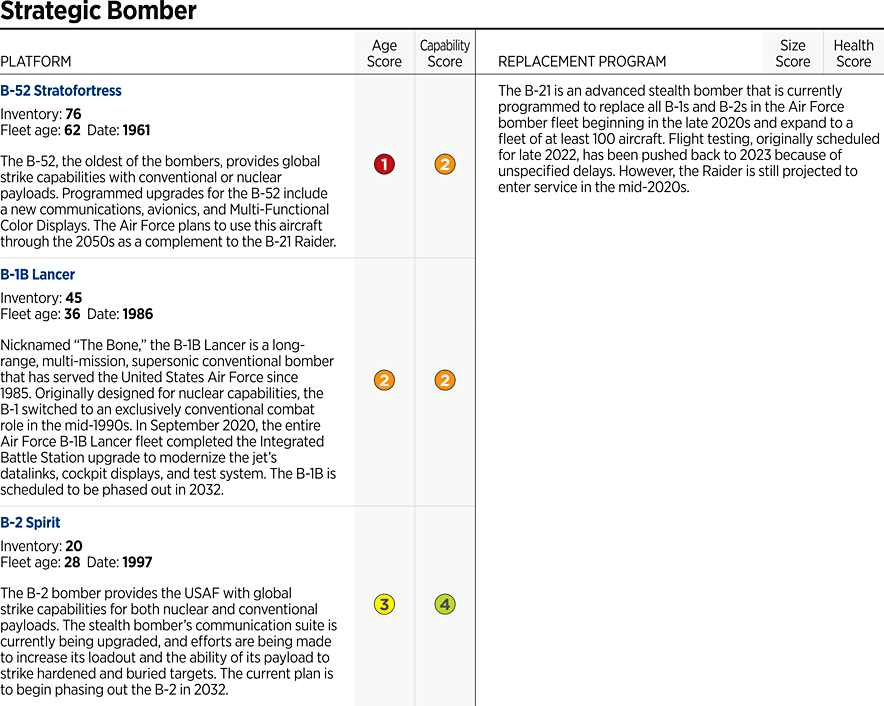
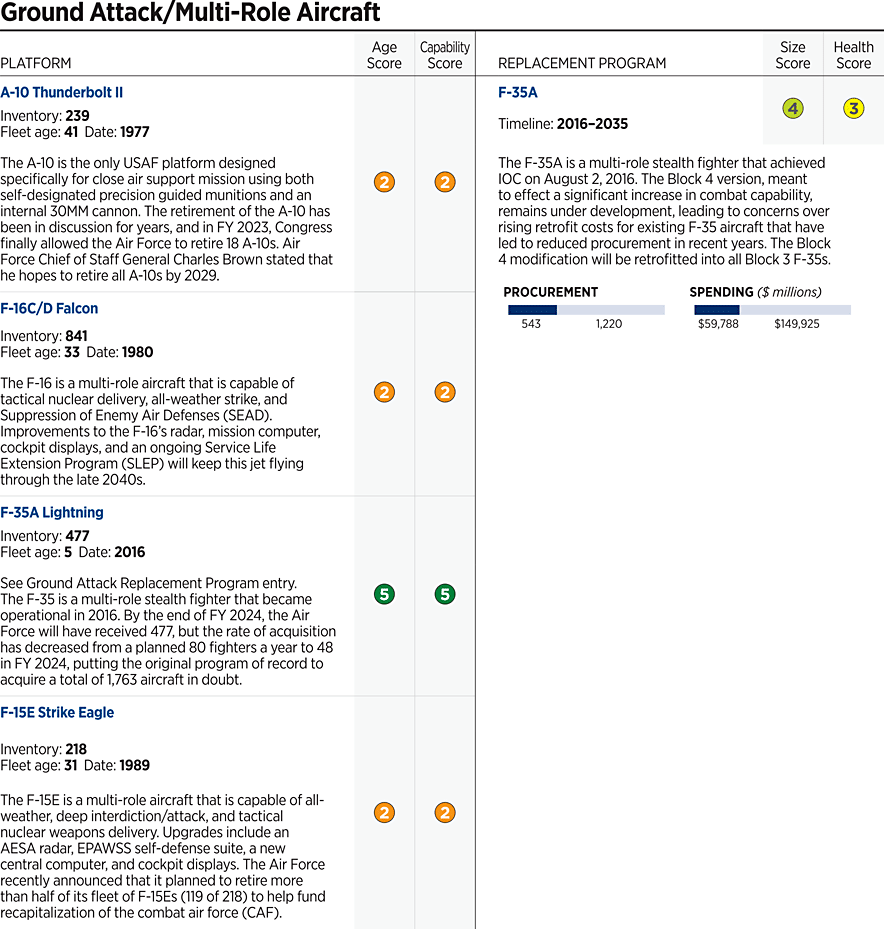
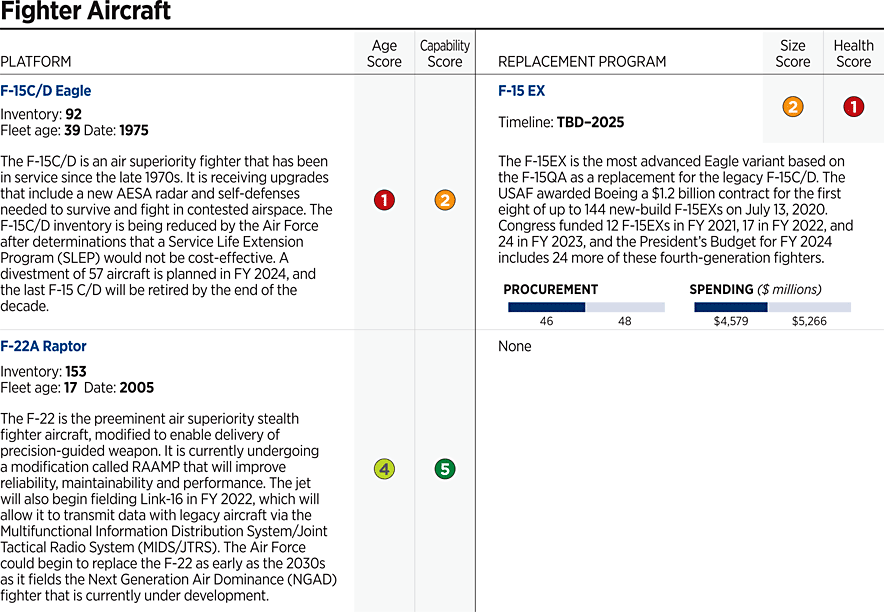
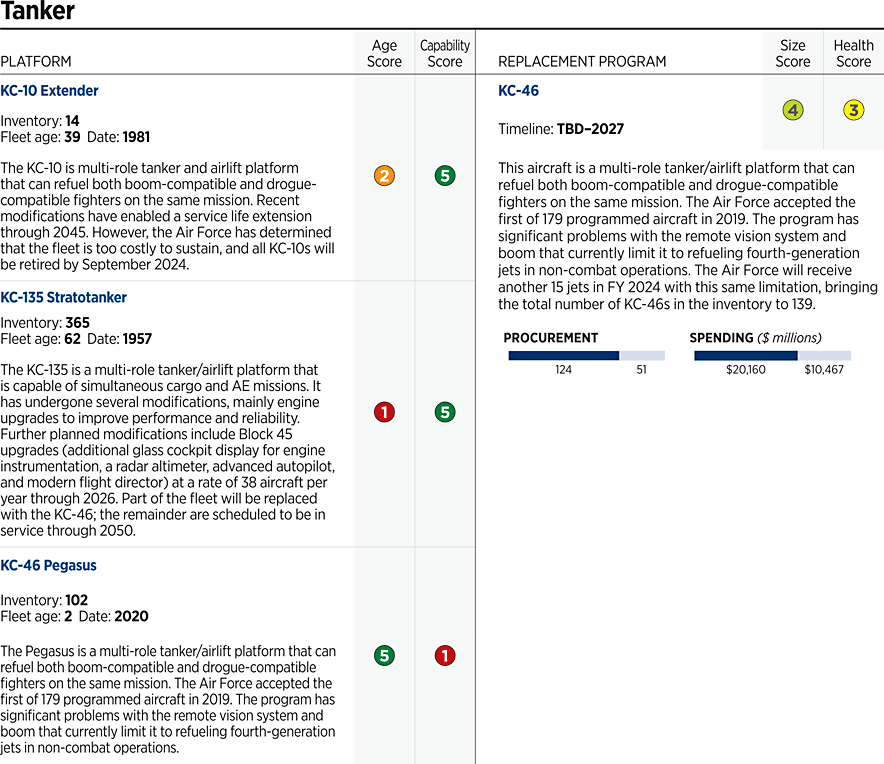
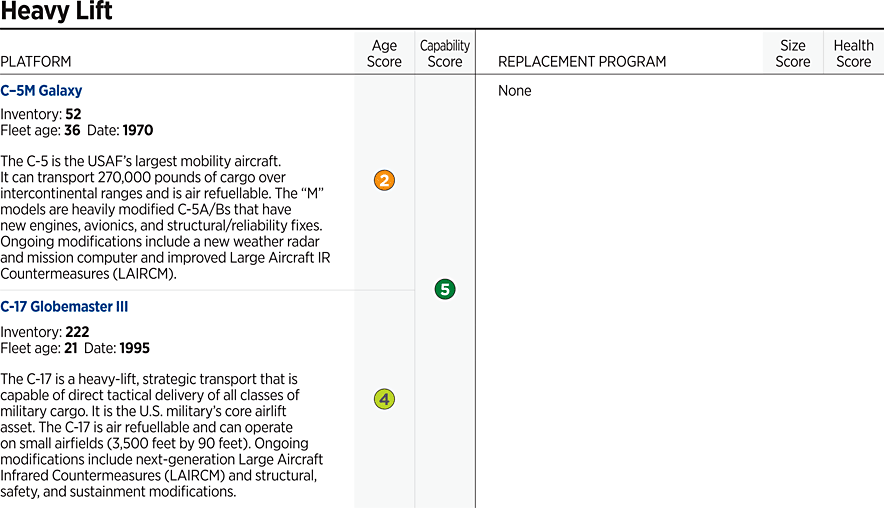
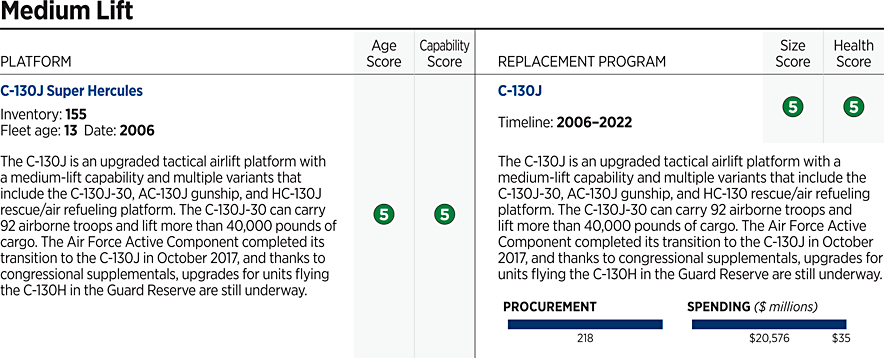
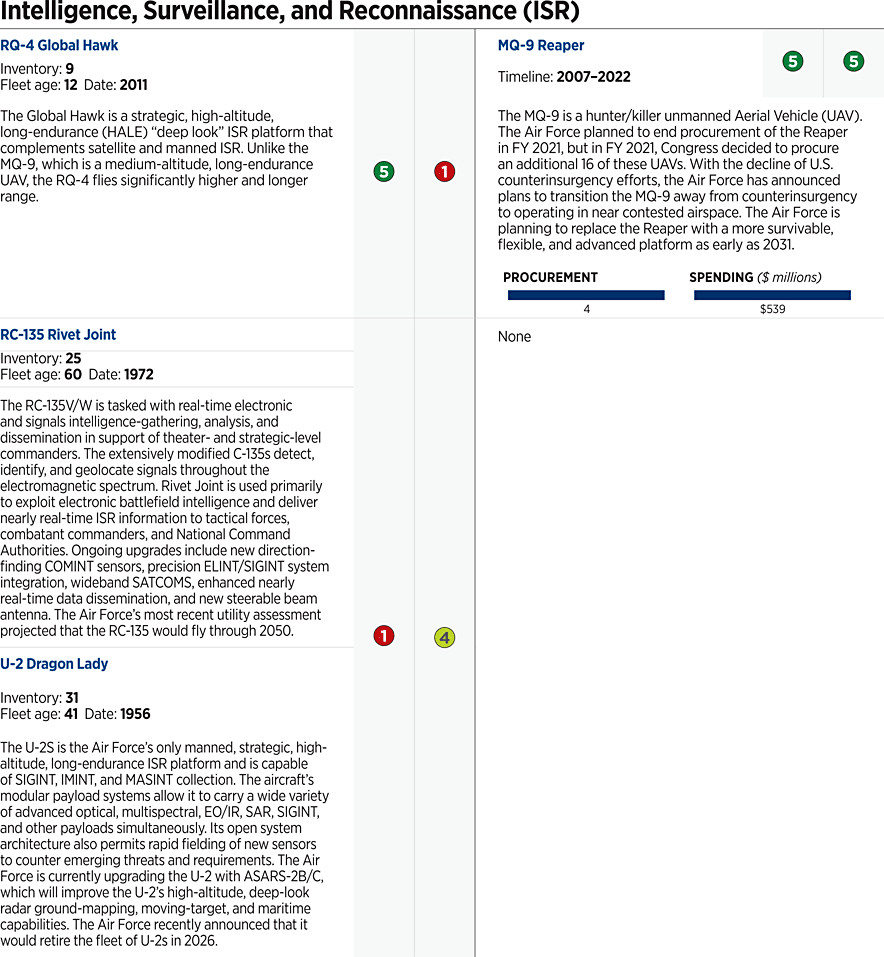
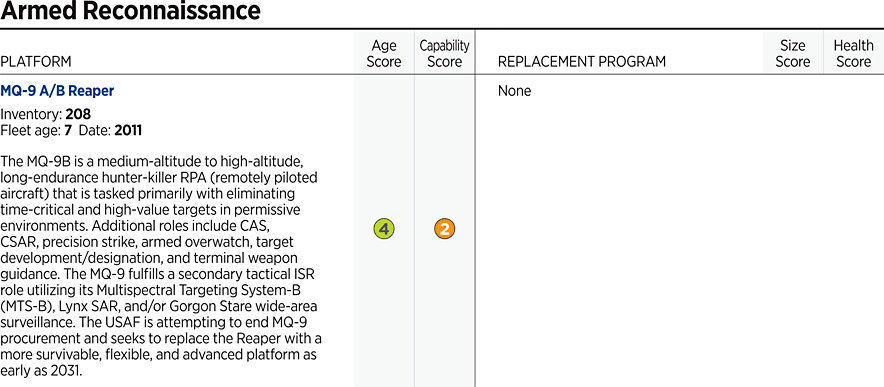
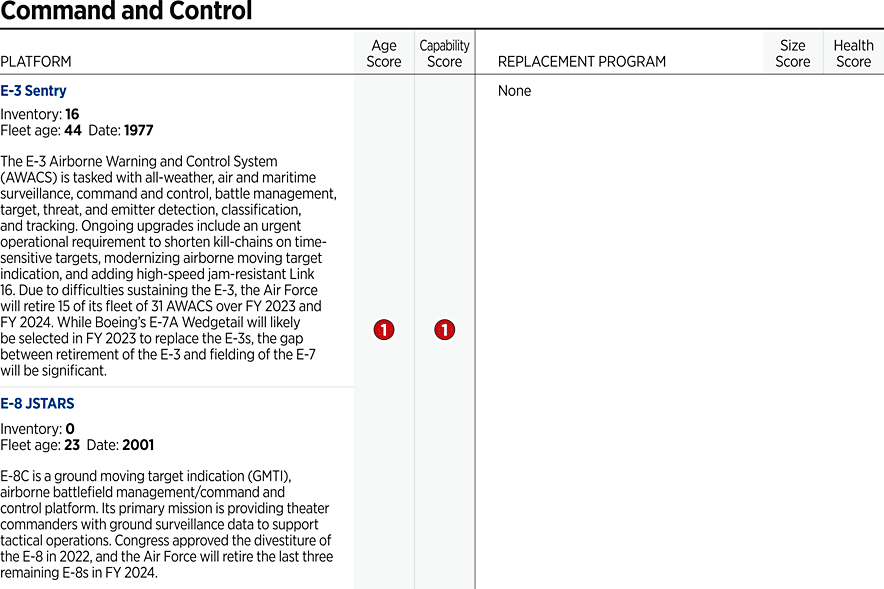
Endnotes
[1] S. 1790, National Defense Authorization Act for Fiscal Year 2020, Public Law 116-92, 116th Cong., December 20, 2019, Title IX, Subtitle D—United States Space Force, https://www.congress.gov/116/plaws/publ92/PLAW-116publ92.pdf (accessed August 25, 2023).
[2] See 2022 Index of U.S. Military Strength, ed. Dakota L. Wood (Washington: The Heritage Foundation, 2022), https://static.heritage.org/2021/2022_Military_Index/2022_IndexOfUSMilitaryStrength_WEB.pdf.
[3] The Honorable Michael B. Donley, Secretary of the Air Force, and General Mark A. Welsh III, Chief of Staff, United States Air Force, “Fiscal Year 2014 Air Force Posture Statement” before the Committee on Armed Services, U.S. House of Representatives, April 12, 2013, p. 2, https://www.af.mil/Portals/1/documents/budget/2014-budget-posture-statement.pdf (accessed August 25, 2023).
[4] John Venable, “Independent Capability Assessment of U.S. Air Force Reveals Readiness Level Below Carter Administration Hollow Force,” Heritage Foundation Backgrounder No. 3208, April 17, 2017, p. 2, https://www.heritage.org/sites/default/files/2017-04/BG3208.pdf.
[5] James Mattis, Secretary of Defense, Summary of the 2018 National Defense Strategy of the United States of America: Sharpening the American Military’s Competitive Edge, U.S. Department of Defense, https://dod.defense.gov/Portals/1/Documents/pubs/2018-National-Defense-Strategy-Summary.pdf (accessed August 25, 2023).
[6] U.S. Air Force, “The Air Force We Need: 386 Operational Squadrons,” September 17, 2018, https://www.af.mil/News/Article-Display/Article/1635070/the-air-force-we-need-386-operational-squadrons/ (accessed August 25, 2023).
[7] While the number of aircraft in any one of those categories varies from unit to unit, there are approximately 30 fighters, 10 bombers, 15 tankers, and 15 strategic airlift aircraft in each squadron. Mathematically, “The Air Force We Need” calls for 182 more fighters, 50 more bombers, 210 more refuelers, and 15 more airlift aircraft than the Air Force currently has in its inventory. Airframe purchases alone would cost approximately $80 billion. That rough estimate is based on the need for 182 more F-35s (seven squadrons, 26 fighters per squadron, $80 million each); 50 more B-21 bombers (five squadrons, 10 bombers per squadron, $564 million each); 210 more KC-46s (14 squadrons, 15 tankers per squadron, $169 million each); and 15 additional C-17s (one squadron, 15 aircraft per squadron, no longer in production but an average of $262 million each in FY 2020 dollars). See, respectively, U.S. Air Force, “The Air Force We Need: 386 Operational Squadrons”; Marcus Weisgerber, “Price Drop: Lockheed Pitches $80M F-35A to Pentagon,” Defense One, May 7, 2019, https://www.defenseone.com/business/2019/05/price-drop-lockheed-pitches-80m-f-35a-pentagon/156825/ (accessed August 25, 2023); Jeremiah Gertler, “Air Force B-21 Raider Long-Range Strike Bomber,” Congressional Research Service Report for Members and Committees of Congress No. R44463, updated September 22, 2021, p. 4, https://fas.org/sgp/crs/weapons/R44463.pdf (accessed August 25, 2023); Exhibit P-40, “Budget Line Item Justification: PB 2020 Air Force, Appropriation / Budget Activity / Budget Sub Activity: 3010F: Aircraft Procurement, Air Force / BA 02: Airlift Aircraft / BSA 2: Tactical Airlift, P-1 Line Item Number / Title: KC046A / KC-46A MDAP,” in U.S. Department of the Air Force, Department of Defense Fiscal Year (FY) 2020 Budget Estimates, Air Force, Justification Book Volume 1 of 2, Aircraft Procurement, Air Force Vol-1, March 2019, p. 25, https://www.saffm.hq.af.mil/Portals/84/documents/FY20/PROCUREMENT/FY20_PB_3010_Aircraft_Vol-1.pdf?ver=2019-03-18-152821-713 (accessed August 25, 2023); and Fact Sheet, “C-17 Globemaster III,” U.S. Air Force, https://www.af.mil/About-Us/Fact-Sheets/Display/Article/1529726/c-17-globemaster-iii/ (accessed August 25, 2023).
[8] Stephen Losey, “Pilots Are Flying 17 Hours per Month, but It’s Still Not Enough, Air Force Secretary Says,” Air Force Times, March 1, 2018, https://www.airforcetimes.com/news/your-air-force/2018/03/01/secaf-air-force-pilots-are-flying-17-hours-per-month-but-its-still-not-enough/ (accessed August 25, 2023).
[9] Extracted from U.S. Air Force budget summaries for the years 2017 through 2021. For example: Table 1, “Air Force Budget Highlights Summary,” in U.S. Department of the Air Force, United States Air Force Fiscal Year 2018 Budget Overview, May 2017, p. 15, http://www.saffm.hq.af.mil/LinkClick.aspx?fileticket=m3vZOmfR368%3d&portalid=84 (accessed August 25, 2023), and Table 1, “Department of the Air Force Budget Summary,” in U.S. Department of the Air Force, Department of the Air Force FY 2021 Budget Overview, p. 2, https://www.saffm.hq.af.mil/Portals/84/documents/FY21/SUPPORT_/FY21%20Budget%20Overview_1.pdf?ver=2020-02-10-152806-743 (accessed August 25, 2023).
[10] Extracted from U.S. Air Force budget summary briefing slides for the years 2017 through 2024. For example: “Department of the FY24 Budget Summary,” and “Procurement” in Honorable Kristyn E. Jones and Major General Mike Greiner, Fiscal Year 2024 Department of the Air Force Budget Overview, PowerPoint Presentation, March 2023, pp. 4 and 8, https://www.saffm.hq.af.mil/Portals/84/documents/FY24/Budget/FY24%20PB%20Rollout%20Brief.pdf?ver=x2W6qI5z2gZqAYJQkjjwaQ%3d%3d (accessed August 25, 2023).
[11] Table E-11, “Flying Hours (FH) Stratified by Regular and Reserve Forces, MAJCOM, and FOA,” in Assistant Secretary of the Air Force (Financial Management and Comptroller of the Air Force), Deputy Assistant Secretary (Cost and Economics), United States Air Force Statistical Digest, Fiscal Year 2013, p. 102, https://www.afhistory.af.mil/Portals/64/Statistics/2013%20AF%20Stat%20Digest.pdf?ver=2017-02-08-092753-677×tamp=1493300749028 (accessed August 25, 2023).
[12] Headquarters U.S. Air Force, A8XC/A5RW, written response to Heritage Foundation request for information, May 24, 2023.
[13] Greg Hadley, “Air Force Leaders Explain 5-Year Divestment Plan and Smaller F-15EX Fleet,” Air & Space Forces Magazine, April 27, 2022, https://www.airforcemag.com/air-force-leaders-five-year-divestment-plan-why-f-15ex-fleet-will-be-smaller/ (accessed August 25, 2023).
[14] Chris Gordon, “Air Force Wants to Cut F-15E Fleet in Half to Focus on Modernizing, Brown Says,” Air & Space Forces Magazine, July 12, 2023, https://www.airandspaceforces.com/air-force-cut-f-15e-fleet-in-half/ (accessed August 25, 2023).
[15] Appendix, “Total Aircraft Inventory (TAI),” in U.S. Department of the Air Force, FY 2024 Department of the Air Force Budget Overview, p. 43, https://www.saffm.hq.af.mil/Portals/84/documents/FY24/Budget/FY24%20Budget%20Overview%20Book.pdf?ver=JjFXW89XqB_YsIGx1wx4IA%3d%3d (accessed August 25, 2023).
[16] In the words of then-Lieutenant General Mark Kelly, Deputy Chief of Staff for Operations, Headquarters U.S. Air Force: “At the end of the day, if a peer fight kicks up, we’re going to have no time and all the money.” Abraham Mahshie, “‘Every Day Is a Shell Game’: Air Force Budget Prioritizes Technology over Warfighting, General Says,” Washington Examiner, February 13, 2020, https://www.washingtonexaminer.com/policy/defense-national-security/every-day-is-a-shell-game-air-force-budget-prioritizes-technology-over-warfighting-general-says (accessed August 25, 2023).
[17] Author’s conversation with Lockheed Martin representative who estimated that it would take two years of herculean efforts and funding to reduce the F-35A production timeline (funding to employable fighter) from two to three years to one to two years. This is driven primarily by “sole source” parts that are produced in other countries where unions and labor laws severely constrain increases in production. “Sole-source” parts are parts that are made in only one location, which means that the fighters on the flightline when the next war begins are the ones the U.S. will have for the first year of the war in addition to a very limited number of attrition replacements that come off what is already in the production line.
[18] The numbers of total aircraft inventory (TAI) and combat-coded aircraft for the active-duty Air Force were derived through review of U.S. Department of the Air Force, FY 2024 Department of the Air Force Budget Overview, and International Institute for Strategic Studies, The Military Balance 2023: The Annual Assessment of Global Military Capabilities and Defence Economics (London: Routledge, 2023), pp. 43–47. Where the two publications were in conflict for TAI, the USAF numbers were generally adopted. Neither document specifies the number of active-duty combat-coded aircraft. That number was derived by tallying the total number of fighters by type and dividing that number by the total number of active-duty squadrons flying those types of aircraft. The numbers and types of aircraft associated with Weapons Instructor Course Squadrons, Adversary Tactics, Test, OT&E, and other units are not standard/determinable and could not be assessed. The associated error is minimized by totaling all like fighter aircraft (F-16, F-15C, etc.); dividing them by the total number of squadrons flying those aircraft; and spreading the error equally across all combat-coded fighter and training units. The total number of fighters associated with non–Fighter Training Unit (FTU) squadrons was counted as combat-coded.
[19] John Venable, “Rebuilding America’s Military: The United States Air Force,” Heritage Foundation Special Report No. 225, March 26, 2020, pp. 42–43, https://www.heritage.org/defense/report/rebuilding-americas-military-the-united-states-air-force.
[20] Ibid.
[21] Headquarters U.S. Air Force, A8XC/A5RW, written response to Heritage Foundation request for information, May 24, 2023.
[22] Jim Edwards, “The Russians Are Screwing with the GPS System to Send Bogus Navigation Data to Thousands of Ships,” Business Insider, April 14, 2019, https://www.businessinsider.com/gnss-hacking-spoofing-jamming-russians-screwing-with-gps-2019-4 (accessed August 25, 2023).
[23] Todd Harrison, Kaitlyn Johnson, Makena Young, Nicholas Wood, and Alyssa Goessler, Space Threat Assessment 2022, Center for Strategic and International Studies, Aerospace Security Project, April 2022, p. 26, https://csis-website-prod.s3.amazonaws.com/s3fs-public/publication/220404_Harrison_SpaceThreatAssessment2022.pdf?K4A9o_D9NmYG2Gv98PxNigLxS4oYpHRa (accessed August 25, 2023).
[24] John R. Hoehn, “Precision-Guided Munitions: Background and Issues for Congress,” Congressional Research Service Report for Members and Committees of Congress No. R45996, updated June 11, 2021, p. 11, https://crsreports.congress.gov/product/pdf/R/R45996 (accessed August 25, 2023).
[25] Theresa Hitchens, “AMC Approves ‘Limited’ KC-46 Tanker Refueling,” Breaking Defense, February 24, 2021, https://breakingdefense.com/2021/02/amc-approves-limited-kc-46-tanker-refueling/ (accessed August 25, 2023).
[26] John Venable, “U.S. Air Force Should Adjust Tanker Acquisition Strategy to Support Strategic Competition with China,” Heritage Foundation Backgrounder No. 3693, March 14, 2022, p. 6, https://www.heritage.org/sites/default/files/2022-03/BG3693.pdf.
[27] Table, “Aircraft Total Active Inventory (TAI) (As of Sept. 30, 2022),” in “Air Force & Space Forces Almanac 2023,” Air & Space Forces Magazine, Vol. 106, No. 6 and 7 (June/July 2023), p. 66, https://www.airandspaceforces.com/app/uploads/2023/06/Almanac2023_Fullissue_REV2.pdf (accessed August 25, 2023).
[28] Ibid. Thirteen months were added because of the difference between the aircraft data capture dates for the 2023 Almanac and publication of this edition of the Index.
[29] Ibid. Thirteen months were added because of the difference between the aircraft data capture dates for the 2023 Almanac and publication of this edition of the Index.
[30] Micah Garbarino, “F-16 Service Life Extension Program a ‘Great Deal’ for Department of Defense, Taxpayers,” Air Force Materiel Command, May 3, 2018, http://www.afmc.af.mil/News/Article-Display/Article/1512449/f-16-service-life-extension-program-a-great-deal-for-department-of-defense-taxp/ (accessed August 25, 2023).
[31] Appendix, “Total Aircraft Inventory (TAI),” in U.S. Department of the Air Force, FY 2024 Department of the Air Force Budget Overview, p. 43.
[32] Headquarters U.S. Air Force, A8, written response to Heritage Foundation request for information, July 11, 2022.
[33] Headquarters U.S. Air Force, A8XC/A5RW, written response to Heritage Foundation request for information, May 24, 2023.
[34] Originally known as the Airborne Battle Management System.
[35] Appendix, “Total Aircraft Inventory (TAI),” in U.S. Department of the Air Force, FY 2024 Department of the Air Force Budget Overview, p. 43.
[36] Jeremiah Gertler, “Air Force F-22 Fighter Program,” Congressional Research Service Report for Congress No. RL31673, July 11, 2013, p. 7, https://www.fas.org/sgp/crs/weapons/RL31673.pdf (accessed August 25, 2023), and Rebecca Grant and Loren Thompson, “Losing Air Dominance? The Air Force and Its Future Roles,” presentation at Air Force Association Air & Space Conference, Washington, D.C., September 16, 2008, p. 3, https://secure.afa.org/Mitchell/presentations/091608LosingAirDominance_tnx.pdf (accessed August 25, 2023). For excellent overviews of the rise and demise of the F-22 program, see Kyle Mizokami, “What Happened to the F-22?” The National Interest, The Reboot Blog, September 12, 2021, https://nationalinterest.org/blog/reboot/what-happened-f-22-193488 (accessed August 25, 2023), and Fred Kaplan, “They Scrapped the F-22!” Slate, July 21, 2009, https://slate.com/news-and-politics/2009/07/the-remarkable-vote-to-kill-the-f-22-and-what-it-means-for-america-s-military-future.html (accessed August 25, 2023).
[37] Congress has signaled its intent to prohibit the retirement of these jets at least temporarily. Kimberly Johnson, “Congress Pushes Back on Air Force Retirement Plans for Older F-22 Raptors,” Flying, June 30, 2022, https://www.flyingmag.com/congress-pushes-back-on-air-force-retirement-plans-for-older-f-22-raptors/ (accessed August 25, 2023).
[38] Headquarters U.S. Air Force, A8XC/A5RW, written response to Heritage Foundation request for information on Air Force PGM expenditures and programmed replenishments, May 24, 2023.
[39] Alex R. Lloyd, “F-22 Raptor Gets Major Upgrades,” Wright-Patterson Air Force Base, corrected January 28, 2021, https://www.wpafb.af.mil/News/Article-Display/Article/2484112/f-22-raptor-gets-major-upgrades/ (accessed August 25, 2023).
[40] John A. Tirpak, “F-35 Flies for the First Time with Tech Refresh 3, Paving the Way for Block 4,” Air & Space Forces Magazine, January 10, 2023, https://www.airandspaceforces.com/f-35-flies-first-time-tech-refresh-3-paving-way-block-4/ (accessed August 25, 2023).
[41] Venable, “Independent Capability Assessment of U.S Air Force Reveals Readiness Level Below Carter Administration Hollow Force,” p. 2, and Dave Majumdar, “Can the F-35 Win a Dogfight?” War Is Boring, December 17, 2013, https://warisboring.com/can-the-f-35-win-a-dogfight/ (accessed August 25, 2023).
[42] Anthony Capaccio, “Under-Wraps B-21 Bomber Is Seen Costing $203 Billion into 2050s,” Bloomberg, November 17, 2021, https://www.bloomberg.com/news/articles/2021-11-17/under-wraps-b-21-bomber-is-seen-costing-203-billion-into-2050s (accessed August 25, 2023).
[43] Small group discussion with the Honorable Heather Wilson, Secretary of the Air Force, February 9, 2018.
[44] Kimberly Johnson, “Report: Air Force Set to Roll Out B-21 Stealth Bomber This Year,” Flying, February 10, 2022, https://www.flyingmag.com/report-air-force-set-to-roll-out-b-21-stealth-bomber-this-year/?nowprocket=1 (accessed August 25, 2023).
[45] Cal Biesecker, “Canceled Defensive System for B-2 Suffered from Coding Challenges, Roper Says,” Defense Daily, February 28, 2020, https://www.defensedaily.com/canceled-defensive-system-b-2-suffered-coding-challenges-roper-says/budget/ (accessed August 25, 2023).
[46] Valerie Insinna, “The Air Force Is Massively Scaling Back a Major Upgrade for the B-2 Stealth Bomber,” Defense News, February 12, 2020, https://www.defensenews.com/smr/federal-budget/2020/02/12/the-air-force-is-massively-scaling-back-a-major-upgrade-for-the-b-2-stealth-bomber/ (accessed August 25, 2023).
[47] Tara Copp, “B-52 Engine Replacement Could Keep Bomber Flying Through Its 100th Birthday,” Defense One, updated June 30, 2021, https://www.defenseone.com/technology/2021/06/engine-replacement-could-keep-venerable-b-52-flying-through-its-100th-birthday/182687/ (accessed August 25, 2023).
[48] Headquarters U.S. Air Force, written response to Heritage Foundation request for information on Air Force PGM expenditures and programmed replenishments, May 24, 2023.
[49] GlobalSecurity.org, “Bridge Tanker,” page last modified September 18, 2021, https://www.globalsecurity.org/military/systems/aircraft/kc-y.htm (accessed August 25, 2023).
[50] Dave Majumdar, “Why the Air Force Won’t Buy the F-15X or ‘New’ F-22 Raptor,” RealClearDefense, September 18, 2018, https://www.realcleardefense.com/articles/2018/09/18/why_the_air_force_wont_buy_the_f-15x_or_new_f-22_raptor_113808.html (accessed August 25, 2023).
[51] The baseline F-15EX will cost $90.2 million to acquire, and that cost does not include the $2.5 million targeting and $10.9 million infrared search and track (IRST) pods the jet will need to match the basic combat capability of the F-35A, which for $91.6 million comes complete with every system it needs to fly in and around high-threat environments. In 2021, Cost Assessment and Program Evaluation (CAPE) produced a slide that showed the operational cost per tail per year for the F-15EX to be $7.7 million, compared to $7.0 million for the F-35A. See John Venable, “Air Force’s Math on the F-15EX and F-35 Doesn’t Add Up,” Heritage Foundation Commentary, April 19, 2022, https://www.heritage.org/defense/commentary/air-forces-math-the-f-15ex-and-f-35-doesnt-add; Exhibit P-40, “Budget Line Item Justification: PB 2023 Air Force, Appropriation / Budget Activity / Budget Sub Activity: 3010F: Aircraft Procurement, Air Force / BA 01: Combat Aircraft / BSA 3: Tactical Forces, P-1 Line Item Number / Title: ATA000 / F-35,” in U.S. Department of the Air Force, Department of Defense Fiscal Year (FY) 2023 Budget Estimates, Air Force, Justification Book Volume 1 of 2, Aircraft Procurement, Air Force, Vol 1, April 2022, p. 7, https://www.saffm.hq.af.mil/Portals/84/documents/FY23/PROCUREMENT_/FY23%20Air%20Force%20Aircraft%20Procurement%20Vol%20I.pdf?ver=G7mDgA6gGUT-vbPL4Xs1jA%3D%3D (accessed August 25, 2023); Exhibit P-40, “Budget Line Item Justification: PB 2023 Air Force, Appropriation / Budget Activity / Budget Sub Activity: 3010F: Aircraft Procurement, Air Force / BA 01: Combat Aircraft / BSA 3: Tactical Forces, P-1 Line Item Number / Title: F015EX / F-15EX,” in ibid., p. 25; news release, “Egypt—Sniper Advanced Targeting Pods (ATPs),” U.S. Department of Defense, Defense Security Cooperation Agency, December 29, 2020, https://www.dsca.mil/sites/default/files/mas/press_release-egypt-20-65_cn.pdf (accessed August 25, 2023); and Thomas Newdick, “Legion Infrared Search and Track Pods Can Now Carry Their Own Datalinks for More Lethal Targeting,” The War Zone, June 8, 2021, https://www.thedrive.com/the-war-zone/40980/legion-infrared-search-and-track-pods-can-now-carry-their-own-datalinks-for-more-lethal-targeting (accessed August 25, 2023).
[52] Aaron Mehta, “Mattis Orders Fighter Jet Readiness to Jump to 80 Percent—in One Year,” Defense News, October 9, 2018, https://www.defensenews.com/air/2018/10/09/mattis-orders-fighter-jet-readiness-to-jump-to-80-percent-in-one-year/ (accessed August 25, 2023).
[53] Brian W. Everstine, “Breaking down USAF’s 70-Percent Overall Mission Capable Rate,” Air & Space Forces Magazine, May 19, 2020, https://www.airandspaceforces.com/breaking-down-usafs-70-percent-overall-mission-capable-rate/ (accessed August 25, 2023).
[54] Kyle Mizokami, “Why the U.S. Just Deployed B-52s to the Middle East,” Popular Mechanics, May 8, 2019, https://www.popularmechanics.com/military/aviation/a27409504/b-52-middle-east/ (accessed August 25, 2023).
[55] The Honorable Dr. Heather Wilson, Secretary of the Air Force, and General David L. Goldfein, Chief of Staff, United States Air Force, “USAF Posture Statement, Fiscal Year 2020,” Department of the Air Force Presentation to the Committees and Subcommittees of the United States Senate and the House of Representatives, 1st Session, 116th Congress, p. 4, https://docs.house.gov/meetings/AP/AP02/20190402/109214/HHRG-116-AP02-Wstate-GoldfeinD-20190402.pdf (accessed August 25, 2023).
[56] General Charles Q. Brown, Jr., and General David H. Berger, “Redefine Readiness or Lose,” War on the Rocks, March 15, 2021, https://warontherocks.com/2021/03/redefine-readiness-or-lose/ (accessed August 25, 2023).
[57] The Honorable John P. Roth, Acting Secretary of the Air Force; General Charles Q. Brown, Jr., Chief of Staff, United States Air Force; and General John W. Raymond, Chief of Space Operations, United States Space Force, “Department of the Air Force Posture Statement, Fiscal Year 2022,” Department of the Air Force Presentation to the Committees and Subcommittees of the United States Senate and the House of Representatives, 1st Session, 117th Congress, p. 12, https://www.af.mil/Portals/1/documents/2021SAF/05_May/FY22_DAF_Posture_Statement.pdf (accessed August 25, 2023).
[58] Air Force News Service, “New Force Generation Model Builds High-End Readiness, Sustainability for Joint Force,” Secretary of the Air Force Public Affairs, August 5, 2021, https://www.af.mil/News/Article-Display/Article/2720333/new-force-generation-model-builds-high-end-readiness-sustainability-for-joint-f/ (accessed August 25, 2023).
[59] The Honorable Heather A. Wilson, Secretary of the Air Force, and General David L. Goldfein, Chief of Staff of the Air Force, statement on “Air Force Budget Posture” before the Committee on Armed Services, U.S. Senate, June 6, 2017, p. 3, https://www.armed-services.senate.gov/imo/media/doc/Wilson-Goldfein_06-06-17.pdf (accessed August 25, 2023).
[60] Headquarters U.S. Air Force, Deputy Chief of Staff for Operations, written response to Heritage Foundation request for information on Air Force manning levels, May 24, 2023.
[61] See Dyess Air Force Base, “7th Operations Group,” https://www.dyess.af.mil/Units/7th-Bomb-Wing/7th-Operations-Group/ (accessed August 25, 2023).
[62] Table, “2022 Aircraft Mission Capable Rates,” in “Air Force & Space Forces Almanac 2023,” p. 683.
[63] Lieutenant General Gina M. Grosso, Deputy Chief of Staff, Manpower, Personnel and Services, United States Air Force, statement on “Military Pilot Shortage” before the Subcommittee on Personnel, Committee on Armed Services, U.S. House of Representatives, March 29, 2017, p. 2, http://docs.house.gov/meetings/AS/AS02/20170329/105795/HHRG-115-AS02-Wstate-GrossoG-20170329.pdf (accessed August 25, 2023).
[64] Headquarters U.S. Air Force, Deputy Chief of Staff for Operations, written response to Heritage Foundation request for information on Air Force manning levels, May 24, 2023.
[65] Ibid.
[66] Air Force Manual 11-2F-35A, Volume 1, Flying Operations, F-35A—Aircrew Training, October 13, 2022, https://static.e-publishing.af.mil/production/1/af_a3/publication/afman11-2f-35av1/afman11-2f-35av1.pdf (accessed August 25, 2023), and “Table 5a—RAP Sortie/Sim Requirements,” F-35A Ready Aircrew Program (RAP) Tasking Memorandum (RTM), hard copy obtained by author through senior Air Force Officer, October 1, 2019.
[67] Venable, “Independent Capability Assessment of U.S. Air Force Reveals Readiness Level Below Carter Administration Hollow Force,” p. 4.
[68] James C. Slife, Creech Blue: Gen Bill Creech and the Reformation of the Tactical Air Forces, 1978–1984 (Maxwell Air Force Base: Air University Press, October 2004), p. 92, https://www.airuniversity.af.edu/Portals/10/AUPress/Books/B_0095_SLIFE_CREECH_BLUE.pdf (accessed August 25, 2023).
[69] John Venable, “A Plan for Keeping the U.S. Air Force’s Best Pilots in Service,” Heritage Foundation Commentary, November 14, 2017, https://www.heritage.org/defense/commentary/plan-keeping-the-us-air-forces-best-pilots-service.
[70] Headquarters U.S. Air Force, Deputy Chief of Staff for Operations, written response to Heritage Foundation request for information on Air Force manning levels, May 14, 2021.
[71] General Mark Kelly, “Air Force Fighter Enterprise,” Air & Space Forces Association Air, Space and Cyber Conference, National Harbor, Maryland, September 21, 2022, https://www.airandspaceforces.com/watch-read-gen-mark-kelly-on-the-air-force-fighter-enterprise/ (accessed August 29, 2023).
[72] Air Force Manual 11-2F-35A, Volume 1, Flying Operations, F-35A—Aircrew Training, and “Table 5a—RAP Sortie/Sim Requirements,” F-35A Ready Aircrew Program (RAP) Tasking Memorandum (RTM).
[73] Oriana Pawlyk, “Cuts to Flight Hours Necessary as Aircraft Sustainment Costs Surge, Air Force General Says,” Military.com, June 23, 2021, https://www.military.com/daily-news/2021/06/23/cuts-flight-hours-necessary-aircraft-sustainment-costs-surge-air-force-general-says.html (accessed August 25, 2023).
[74] Table 2, “United States Air Force Budget Summary,” in U.S. Department of the Air Force, FY 2024 Department of the Air Force Budget Overview, p. 4.
[75] The flying hour budget for FY 2013 was $7.1 billion in then-year dollars. The flying hour budget for FY 2023 is $5.87 billion. Extracted from U.S. Air Force budget summaries for the years 2013 and 2023. U.S. Department of the Air Force, United States Air Force FY 2013 Budget Overview, February 2012, p. 12, https://www.saffm.hq.af.mil/Portals/84/documents/FY13/AFD-120209-052.pdf?ver=2016-08-24-090344-023 (accessed August 25, 2023), and U.S. Department of the Air Force, Department of the Air Force FY 2023 Budget Overview, p. 3, https://www.saffm.hq.af.mil/Portals/84/documents/FY23/SUPPORT_/BOB_28Mar_1125_LoRes.pdf?ver=5nrA8bBfhWoUSrvZ09CeHA%3d%3d (accessed August 25, 2023).
[76] General Charles Q. Brown, Jr., and General David H. Berger, “Redefine Readiness or Lose,” War on the Rocks, March 15, 2021, https://warontherocks.com/2021/03/redefine-readiness-or-lose/ (accessed August 25, 2023).
[77] Author’s experience through 26 years of Air Force operations coupled with senior leader engagements from 2018–2019.
[78] See Table A.1, “Calculating Unit Absorption Capacity,” in Albert A. Robbert, Anthony D. Rosello, Clarence R. Anderegg, John A. Ausink, James H. Bigelow, William W. Taylor, and James Pita, Reducing Air Force Fighter Pilot Shortages (Santa Monica, CA: RAND Corporation, 2015), p. 33, https://www.rand.org/content/dam/rand/pubs/research_reports/RR1100/RR1113/RAND_RR1113.pdf (accessed August 26, 2023).
[79] Even though active-duty fighter squadrons have an average of 30 aircraft per squadron, that number includes maintenance spare and attrition reserve platforms. Manning is based on Primary Assigned Aircraft (PAA), which is 24 aircraft for active-duty fighter squadrons.
[80] Based on a squadron with 24 Primary Assigned Aircraft. Units with 18 PAA require four additional pilots.
[81] Perversely, this reduction of squadrons per wing means that in many wings, a wing staff with its commanding officer (usually a colonel but sometimes a brigadier general) oversees the operation of a single squadron that has its own staff and commander. In such a situation, the question then becomes: Why are both commanders and staffs needed?
[82] The very premise of these units is that they are manned with citizen soldiers whose main source of income is a full-time civilian job and who are committed to travel and temporary duty locations that make them unavailable for days or weeks at a time. Those units would likely require several days to assemble the manpower needed to deploy, and once an assessment of their real mission currency was made, they would need some period of intense training before a responsible senior leader could employ them in a fight with a peer competitor.
[83] “Deployments most suited to the ARC are those in which there is long lead time (six months or more), and in which the operation is of short duration (six days or less), requiring a small force package (12 aircraft or less), and in which the scheduling is flexible.” John T. Correll, “Future Total Force,” Air Force Magazine, Vol. 82, No. 7 (July 1999), p. 32, https://www.airforcemag.com/PDF/MagazineArchive/Documents/1999/July%201999/0799total.pdf (accessed August 26, 2023).
[84] The author commanded the 349th Expeditionary Combat Group at Al Udeid, Qatar, from 2004–2005. During that time, he flew with seven different Air National Guard F-16 squadrons. Every one of those units had some level of rainbow manning, and each performed admirably.
[85] Interview with senior Air National Guard leader, November 20, 2019.
[86] The number of fighters needed for a two-MRC strategy is based on a Heritage Foundation study of airpower requirements and actual fighter deployments for all major combat operations and conflicts from 1950 through 2021.
[87] Kelly, “Air Force Fighter Enterprise.”
[88] See Venable, “Independent Capability Assessment of U.S. Air Force Reveals Readiness Level Below Carter Administration Hollow Force.”
[89] The FY 2023 Air Force posture statement does not discuss current posture; it makes declarative allusions as to what the service should or must be ready to do. For example: “[T]o provide effective integrated deterrence, the Department of the Air Force must be fully ready to expeditiously transition to a wartime posture. We must be ready to mobilize against a peer competitor who has spent decades researching and developing the means to attack the systems and infrastructure we depend on to go to war through cyber and non-cyber means.” The Honorable Frank Kendall, Secretary of the Air Force; General John W. Raymond, Chief of Space Operations, United States Space Force; and General Charles Q. Brown, Jr., Chief of Staff, United States Air Force, “Department of the Air Force Posture Statement, Fiscal Year 2023,” Department of the Air Force Presentation to the Committees and Subcommittees of the United States Senate and the House of Representatives, 2nd Session, 117th Congress, p. 5, https://www.af.mil/Portals/1/documents/2022SAF/FY23_DAF_Posture_Statement.pdf (accessed August 26, 2023).
U.S. Air Force Modernization Table Citations
General Sources
- U.S. Department of the Air Force, Department of Defense Fiscal Year (FY) 2024 Budget Estimates, Air Force, Justification Book Volume 1 of 2, Aircraft Procurement, Air Force, March 2023, https://www.saffm.hq.af.mil/Portals/84/documents/FY24/Procurement/FY24%20Air%20Force%20Aircraft%20Procurement%20Vol%20I.pdf?ver=NMExUp6ZOJkMDUTjzBwtbA%3d%3d (accessed September 14, 2023).
Program Sources
B-21:
- Table, “Aircraft Total Active Inventory (TAI) (As of Sept. 30, 2022),” in “Air Force & Space Forces Almanac 2023,” Air & Space Forces Magazine, Vol. 106, No. 6 and 7 (June/July 2023), p. 66, https://www.airandspaceforces.com/app/uploads/2023/06/Almanac2023_Fullissue_REV2.pdf (accessed September 15, 2023).
- John Venable, “Acquiring the Air Force We Need,” The Mitchell Forum, No. 31 (June 2020), https://a2dd917a-65ab-41f1-ab11-5f1897e16299.usrfiles.com/ugd/a2dd91_681c25bfb72c46769d2004894ed1ea3a.pdf (accessed September 14, 2023).
- Jeremiah Gertler, “Air Force B-21 Raider Long-Range Strike Bomber,” Congressional Research Service Report for Members and Committees of Congress No. R44463, updated September 22, 2021, https://sgp.fas.org/crs/weapons/R44463.pdf (accessed September 14, 2023).
- Brent M. Eastwood, “Stealth Surprises: The U.S. Has Big Plans for the B-21 Raider,” 1945, May 10, 2022, https://www.19fortyfive.com/2022/05/b-21-stealth-bomber-production/ (accessed September 14, 2023).
- John A. Tirpak, “B-21 Raider First Flight Now Postponed to 2023,” Air & Space Forces Magazine, May 20, 2022, https://www.airforcemag.com/b-21-raider-first-flight-now-postponed-to-2023 (accessed September 14, 2023).
F-35A
- Table, “Aircraft Total Active Inventory (TAI) (As of Sept. 30, 2022),” in “Air Force & Space Forces Almanac 2023,” Air & Space Forces Magazine, Vol. 106, No. 6 and 7 (June/July 2023), p. 66, https://www.airandspaceforces.com/app/uploads/2023/06/Almanac2023_Fullissue_REV2.pdf (accessed September 15, 2023).
- Stephen Losey, “One-Third of F-35s Could Be Delivered Before Operational Testing Is Complete,” Defense News, April 25, 2022, https://www.defensenews.com/air/2022/04/25/one-third-of-f-35s-could-be-delivered-before-operational-testing-complete/ (accessed September 14, 2023).
- U.S. Department of the Air Force, Department of Defense Fiscal Year (FY) 2023 Budget Estimates, Air Force, Justification Book Volume 1 of 2, Aircraft Procurement, Air Force, Vol 1, May 2022, https://www.saffm.hq.af.mil/Portals/84/documents/FY23/PROCUREMENT_/FY23%20Air%20Force%20Aircraft%20Procurement%20Vol%20I.pdf?ver=G7mDgA6gGUT-vbPL4Xs1jA%3d%3d (accessed September 14, 2023).
F-15EX Strike Eagle
- Table, “Aircraft Total Active Inventory (TAI) (As of Sept. 30, 2022),” in “Air Force & Space Forces Almanac 2023,” Air & Space Forces Magazine, Vol. 106, No. 6 and 7 (June/July 2023), p. 66, https://www.airandspaceforces.com/app/uploads/2023/06/Almanac2023_Fullissue_REV2.pdf (accessed September 15, 2023).
- U.S. Department of the Air Force, Department of Defense Fiscal Year (FY) 2023 Budget Estimates, Air Force, Justification Book Volume 1 of 2, Aircraft Procurement, Air Force, Vol 1,April 2022, https://www.saffm.hq.af.mil/Portals/84/documents/FY23/PROCUREMENT_/FY23%20Air%20Force%20Aircraft%20Procurement%20Vol%20I.pdf?ver=G7mDgA6gGUT-vbPL4Xs1jA%3d%3d (accessed September 15, 2023).
KC-46 Pegasus
- Table, “Aircraft Total Active Inventory (TAI) (As of Sept. 30, 2022),” in “Air Force & Space Forces Almanac 2023,” Air & Space Forces Magazine, Vol. 106, No. 6 and 7 (June/July 2023), p. 66, https://www.airandspaceforces.com/app/uploads/2023/06/Almanac2023_Fullissue_REV2.pdf (accessed September 15, 2023).
- U.S. Department of the Air Force, Department of Defense Fiscal Year (FY) 2023 Budget Estimates, Air Force, Justification Book Volume 1 of 2, Aircraft Procurement, Air Force, Vol 1, April 2022, https://www.saffm.hq.af.mil/Portals/84/documents/FY23/PROCUREMENT_/FY23%20Air%20Force%20Aircraft%20Procurement%20Vol%20I.pdf?ver=G7mDgA6gGUT-vbPL4Xs1jA%3d%3d (accessed September 15, 2023).
- Marcus Weisgerber, “KC-46 Tankers Expand Mission Workload, Start Refueling F-35s,” Defense One, July 7, 2021, https://www.defenseone.com/business/2021/07/kc-46-tankers-expand-mission-workload-start-refueling-f-35s/183155/ (accessed September 15, 2023).
- Jan Tegler, “Air Force Seeks to Bridge Aerial Refueling Gap,” National Defense Magazine, March 14, 2022, https://www.nationaldefensemagazine.org/articles/2022/3/14/air-force-seeks-to-bridge-aerial-refueling-gap (accessed September 15, 2023).
C-130J
- Table, “Aircraft Total Active Inventory (TAI) (As of Sept. 30, 2022),” in “Air Force & Space Forces Almanac 2023,” Air & Space Forces Magazine, Vol. 106, No. 6 and 7 (June/July 2023), p. 66, https://www.airandspaceforces.com/app/uploads/2023/06/Almanac2023_Fullissue_REV2.pdf (accessed September 15, 2023).
- William McCormick, “Lockheed Martin Receives 3rd Installment of $3B Multiyear Award from U.S. Government to Deliver 50 C-130Js; Rod McLean Quoted,” ExecutiveGov, January 13, 2020, https://executivegov.com/2020/01/lockheed-martin-receives-3rd-installment-of-3b-multiyear-award-from-us-government-to-to-deliver-50-c-130js-rod-mclean-quoted/ (accessed September 15, 2023).
MQ-9 Reaper
B-52 Stratofortress
- Table, “Aircraft Total Active Inventory (TAI) (As of Sept. 30, 2022),” in “Air Force & Space Forces Almanac 2023,” Air & Space Forces Magazine, Vol. 106, No. 6 and 7 (June/July 2023), p. 66, https://www.airandspaceforces.com/app/uploads/2023/06/Almanac2023_Fullissue_REV2.pdf (accessed September 15, 2023).
- Valerie Insinna, “Congress Resurrects MQ-9 Reaper Program, Adding 16 Drones for the Air Force,” Defense News, December 22, 2020, https://www.defensenews.com/air/2020/12/22/congress-resurrected-the-mq-9-reaper-program-adding-16-drones-for-the-air-force/ (accessed September 15, 2023).
- Table, “Aircraft Total Active Inventory (TAI) (As of Sept. 30, 2022),” in “Air Force & Space Forces Almanac 2023,” Air & Space Forces Magazine, Vol. 106, No. 6 and 7 (June/July 2023), p. 66, https://www.airandspaceforces.com/app/uploads/2023/06/Almanac2023_Fullissue_REV2.pdf (accessed September 15, 2023).
B-1B Lancer
- Table, “Aircraft Total Active Inventory (TAI) (As of Sept. 30, 2022),” in “Air Force & Space Forces Almanac 2023,” Air & Space Forces Magazine, Vol. 106, No. 6 and 7 (June/July 2023), p. 66, https://www.airandspaceforces.com/app/uploads/2023/06/Almanac2023_Fullissue_REV2.pdf (accessed September 15, 2023).
- Brian W. Everstine, “B-1B Fleet Finishes Integrated Battle Station Upgrade,” Air & Space Forces Magazine, September 24, 2020, https://www.airforcemag.com/b-1b-fleet-finishes-integrated-battle-station-upgrade/ (accessed September 15, 2023).
- Boeing, “B-1B Lancer,” https://www.boeing.com/defense/b-1b-bomber/ (accessed September 15, 2023).
B-2 Spirit
- Table, “Aircraft Total Active Inventory (TAI) (As of Sept. 30, 2022),” in “Air Force & Space Forces Almanac 2023,” Air & Space Forces Magazine, Vol. 106, No. 6 and 7 (June/July 2023), p. 66, https://www.airandspaceforces.com/app/uploads/2023/06/Almanac2023_Fullissue_REV2.pdf (accessed September 15, 2023).
A-10 Thunderbolt II
- Table, “Aircraft Total Active Inventory (TAI) (As of Sept. 30, 2022),” in “Air Force & Space Forces Almanac 2023,” Air & Space Forces Magazine, Vol. 106, No. 6 and 7 (June/July 2023), p. 66, https://www.airandspaceforces.com/app/uploads/2023/06/Almanac2023_Fullissue_REV2.pdf (accessed September 15, 2023).
- Kyle Mizokami, “The Air Force Really Wants to Kill the A-10 Warthog,” Popular Mechanics, December 8, 2020, https://www.popularmechanics.com/military/aviation/a34907462/air-force-wants-to-retire-a-10-thunderbolt-warthog-congress-opposition/ (accessed September 15, 2023).
- Stephen Losey, “US Air Force Wants to Retire All A-10s by 2029,” Defense News, March 9, 2023, https://www.defensenews.com/air/2023/03/09/us-air-force-wants-to-retire-all-a-10s-by-2029/ (accessed September 15, 2023).
- Thomas Novelly, “A-10s Were Saved from Retirement for Years. Congress May Not Swoop to the Rescue This Time,” Military.com, June 20, 2023, https://www.military.com/daily-news/2023/06/20/10s-were-saved-retirement-years-congress-may-not-swoop-rescue-time.html (accessed September 15, 2023).
F-16 Fighting Falcon
F-35 A Lightning
- Table, “Aircraft Total Active Inventory (TAI) (As of Sept. 30, 2022),” in “Air Force & Space Forces Almanac 2023,” Air & Space Forces Magazine, Vol. 106, No. 6 and 7 (June/July 2023), p. 66, https://www.airandspaceforces.com/app/uploads/2023/06/Almanac2023_Fullissue_REV2.pdf (accessed September 15, 2023).
- News release, “U.S. Air Force Authorizes Extended Service Life for F-16” Lockheed Martin, April 12, 2017, https://news.lockheedmartin.com/2017-04-12-U-S-Air-Force-Authorizes-Extended-Service-Life-for-F-16 (accessed September 15, 2023).
- Table, “Aircraft Total Active Inventory (TAI) (As of Sept. 30, 2022),” in “Air Force & Space Forces Almanac 2023,” Air & Space Forces Magazine, Vol. 106, No. 6 and 7 (June/July 2023), p. 66, https://www.airandspaceforces.com/app/uploads/2023/06/Almanac2023_Fullissue_REV2.pdf (accessed September 15, 2023).
F-15C/D Eagle
- Table, “Aircraft Total Active Inventory (TAI) (As of Sept. 30, 2022),” in “Air Force & Space Forces Almanac 2023,” Air & Space Forces Magazine, Vol. 106, No. 6 and 7 (June/July 2023), p. 66, https://www.airandspaceforces.com/app/uploads/2023/06/Almanac2023_Fullissue_REV2.pdf (accessed September 15, 2023).
- Stephen Losey, “US Air Force Pursues Major Aircraft Retirements in 2024,” Defense News, March 13, 2023, https://www.defensenews.com/air/2023/03/13/us-air-force-pursues-major-aircraft-retirements-in-2024/ (accessed September 15, 2023).
F-15E Strike Eagle
- Table, “Aircraft Total Active Inventory (TAI) (As of Sept. 30, 2022),” in “Air Force & Space Forces Almanac 2023,” Air & Space Forces Magazine, Vol. 106, No. 6 and 7 (June/July 2023), p. 66, https://www.airandspaceforces.com/app/uploads/2023/06/Almanac2023_Fullissue_REV2.pdf (accessed September 15, 2023).
F-22 Raptor
- Table, “Aircraft Total Active Inventory (TAI) (As of Sept. 30, 2022),” in “Air Force & Space Forces Almanac 2023,” Air & Space Forces Magazine, Vol. 106, No. 6 and 7 (June/July 2023), p. 66, https://www.airandspaceforces.com/app/uploads/2023/06/Almanac2023_Fullissue_REV2.pdf (accessed September 15, 2023).
- Shaun Waterman, “F-22’s Agile Developers to Deliver First Link 16 Capability Next Year,” Air & Space Forces Magazine, November 1, 2019, https://www.airforcemag.com/f-22s-agile-developers-to-deliver-first-link-16-capability-next-year/ (accessed September 15, 2023).
KC-10 Extender
- Table, “Aircraft Total Active Inventory (TAI) (As of Sept. 30, 2022),” in “Air Force & Space Forces Almanac 2023,” Air & Space Forces Magazine, Vol. 106, No. 6 and 7 (June/July 2023), p. 66, https://www.airandspaceforces.com/app/uploads/2023/06/Almanac2023_Fullissue_REV2.pdf (accessed September 15, 2023).
- Rossi Pedroza-Bertrand, “End of the 10,” U.S. Department of Defense, Defense Visual Information Distribution Service, January 30, 2023, https://www.dvidshub.net/news/437483/end-10 (accessed September 15, 2023).
KC-135 Stratotanker
- Table, “Aircraft Total Active Inventory (TAI) (As of Sept. 30, 2022),” in “Air Force & Space Forces Almanac 2023,” Air & Space Forces Magazine, Vol. 106, No. 6 and 7 (June/July 2023), p. 66, https://www.airandspaceforces.com/app/uploads/2023/06/Almanac2023_Fullissue_REV2.pdf (accessed September 15, 2023).
KC-46 Pegasus
- Table, “Aircraft Total Active Inventory (TAI) (As of Sept. 30, 2022),” in “Air Force & Space Forces Almanac 2023,” Air & Space Forces Magazine, Vol. 106, No. 6 and 7 (June/July 2023), p. 66, https://www.airandspaceforces.com/app/uploads/2023/06/Almanac2023_Fullissue_REV2.pdf (accessed September 15, 2023).
C-5M Galaxy
- Table, “Aircraft Total Active Inventory (TAI) (As of Sept. 30, 2022),” in “Air Force & Space Forces Almanac 2023,” Air & Space Forces Magazine, Vol. 106, No. 6 and 7 (June/July 2023), p. 66, https://www.airandspaceforces.com/app/uploads/2023/06/Almanac2023_Fullissue_REV2.pdf (accessed September 15, 2023).
C-17 Globemaster III
- Table, “Aircraft Total Active Inventory (TAI) (As of Sept. 30, 2022),” in “Air Force & Space Forces Almanac 2023,” Air & Space Forces Magazine, Vol. 106, No. 6 and 7 (June/July 2023), p. 66, https://www.airandspaceforces.com/app/uploads/2023/06/Almanac2023_Fullissue_REV2.pdf (accessed September 15, 2023).
C-130J Super Hercules
- Table, “Aircraft Total Active Inventory (TAI) (As of Sept. 30, 2022),” in “Air Force & Space Forces Almanac 2023,” Air & Space Forces Magazine, Vol. 106, No. 6 and 7 (June/July 2023), p. 66, https://www.airandspaceforces.com/app/uploads/2023/06/Almanac2023_Fullissue_REV2.pdf (accessed September 15, 2023).
RQ-4 Global Hawk
- Table, “Aircraft Total Active Inventory (TAI) (As of Sept. 30, 2022),” in “Air Force & Space Forces Almanac 2023,” Air & Space Forces Magazine, Vol. 106, No. 6 and 7 (June/July 2023), p. 66, https://www.airandspaceforces.com/app/uploads/2023/06/Almanac2023_Fullissue_REV2.pdf (accessed September 15, 2023).
MQ-9 A/B Reaper
- Table, “Aircraft Total Active Inventory (TAI) (As of Sept. 30, 2022),” in “Air Force & Space Forces Almanac 2023,” Air & Space Forces Magazine, Vol. 106, No. 6 and 7 (June/July 2023), p. 66, https://www.airandspaceforces.com/app/uploads/2023/06/Almanac2023_Fullissue_REV2.pdf (accessed September 15, 2023).
RC-135 Rivet Joint
- Table, “Aircraft Total Active Inventory (TAI) (As of Sept. 30, 2022),” in “Air Force & Space Forces Almanac 2023,” Air & Space Forces Magazine, Vol. 106, No. 6 and 7 (June/July 2023), p. 66, https://www.airandspaceforces.com/app/uploads/2023/06/Almanac2023_Fullissue_REV2.pdf (accessed September 15, 2023).
U-2 Dragon Lady
- Table, “Aircraft Total Active Inventory (TAI) (As of Sept. 30, 2022),” in “Air Force & Space Forces Almanac 2023,” Air & Space Forces Magazine, Vol. 106, No. 6 and 7 (June/July 2023), p. 66, https://www.airandspaceforces.com/app/uploads/2023/06/Almanac2023_Fullissue_REV2.pdf (accessed September 15, 2023).
E-3 Sentry
- Table, “Aircraft Total Active Inventory (TAI) (As of Sept. 30, 2022),” in “Air Force & Space Forces Almanac 2023,” Air & Space Forces Magazine, Vol. 106, No. 6 and 7 (June/July 2023), p. 66, https://www.airandspaceforces.com/app/uploads/2023/06/Almanac2023_Fullissue_REV2.pdf (accessed September 15, 2023).
E-8 JSTARS
- Table, “Aircraft Total Active Inventory (TAI) (As of Sept. 30, 2022),” in “Air Force & Space Forces Almanac 2023,” Air & Space Forces Magazine, Vol. 106, No. 6 and 7 (June/July 2023), p. 66, https://www.airandspaceforces.com/app/uploads/2023/06/Almanac2023_Fullissue_REV2.pdf (accessed September 15, 2023).
